Pediatric. kb 2
151) An awake, alert infant with a 2-day history of diarrhea presents with a depressed fontanelle, tachycardia, sunken eyes, and the loss of skin elasticity. Which of the following is the correct percentage of dehydration?
A) Less than 1%
B) 1% to 5%
C) 5% to 9%
D) 10% to 15%
E) More than 20%
152) A 9-month-old is brought to the emergency center by ambulance. The child had been having emesis and diarrhea with decreased urine output for severaldays, and the parents noted that she was hard to wake up this morning. Her weight is 9 kg, down from 11 kg the week prior at her 9-month checkup. You note her heart rate and blood pressure to be normal. She is lethargic, and her skin is noted to be “doughy.” After confirming that her respiratory status is stable, you send electrolytes, which you expect to be abnormal. You start an IV. Which of the following is the best solution for an initial IV bolus?
A) One-fourth normal saline (38.5 mEq sodium/L)
B) D10 water (100 g glucose/L)
C) Normal saline (154 mEq sodium/L)
D) 3% saline (513 mEq sodium/L)
E) Fresh-frozen plasma
153) You are admitting to the hospital a 3-month-old infant who has been having poor feeding, emesis, and diarrhea for 3 days. In the emergency center, her electrolytes were found to be: sodium 157 mEq/L, potassium 2.6 mEq/L, chloride120 mEq/L, bicarbonate 14 mEq/L,creatinine1.8 mEq/L, blood urea nitrogen(BUN) 68 mEq/L, and glucose195 mEq/L. She was given a fluid bolus in the emergency center and has subsequently produced urine. Which of the following is the most appropriate next step in her management?
A) Slow rehydration over 48 hours
B) Continued rapid volume expansion with 1/4 normal saline
C) Packed red blood cells (RBCs)
D) Rehydration with free water
E) Urinary electrolytes
154) The mother of a 6-month-old infant is concerned that her baby may be teething. You explain to her that the first teeth to erupt in most children are which of the following?
A) Mandibular central incisors
B) Maxillary lateral incisors
C) Maxillary first molars
D) Mandibular cuspids (canines)
E) First premolars (bicuspids)
155) An 8-year-old boy is brought to your office with the complaint of abdominal pain. The pain is worse during the week and seems to be less prominent during the weekends and during the summer. The patient’s growth and development are normal. The physical examination is unremarkable. Laboratory screening, including stool for occult blood, CBC, urinalysis, and chemistry panel, yields normal results. Which of the following is the best next step in the care of this patient?
A) Perform an upper GI series
B) Perform CT of the abdomen
C) Administer a trial of H2 blockers
D) Observe the patient and reassure the patient and family
E) Recommend a lactose-free diet
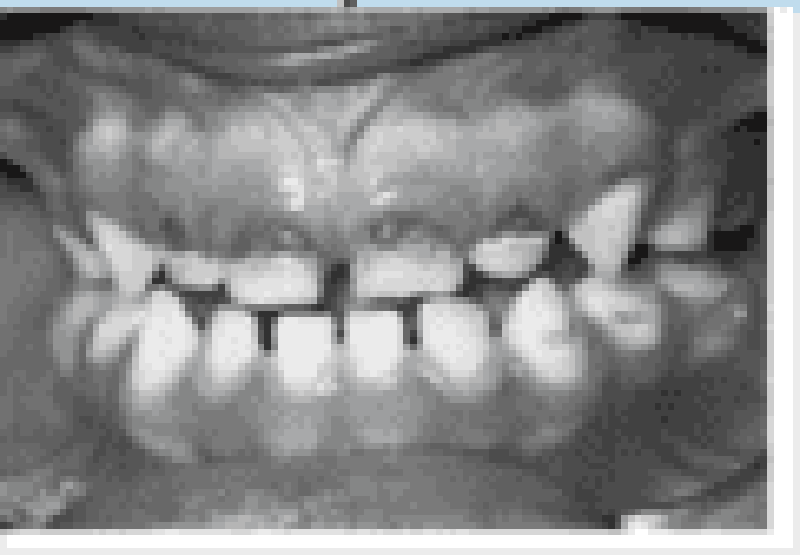
156) The 4-year-old child pictured below is noted to have the tooth decay as shown. This characteristic pattern of tooth decay is caused by which of the following?
A) Excessive use of fluoride
B) Tetracycline
C) Use of bottled water that lacks fluoride
D) Prolonged use of a baby bottle
E) Consumption of too much candy
157) A 12-year-old girl was hit in the face by a baseball 15 minutes earlier and has had her mandibular incisors knocked out. Which of the following represents the best plan of action?
A) The teeth should be rinsed in hot water then carefully dried.
B) Foreign matter adhering to the teeth should be immediately scrubbed off.
C) The teeth may be transported in tea, juice, or cola.
D) Avulsed teeth can be transported in the mouth of the parent or a cooperative patient.
E) A dental appointment should be made within 48 to 72 hours.
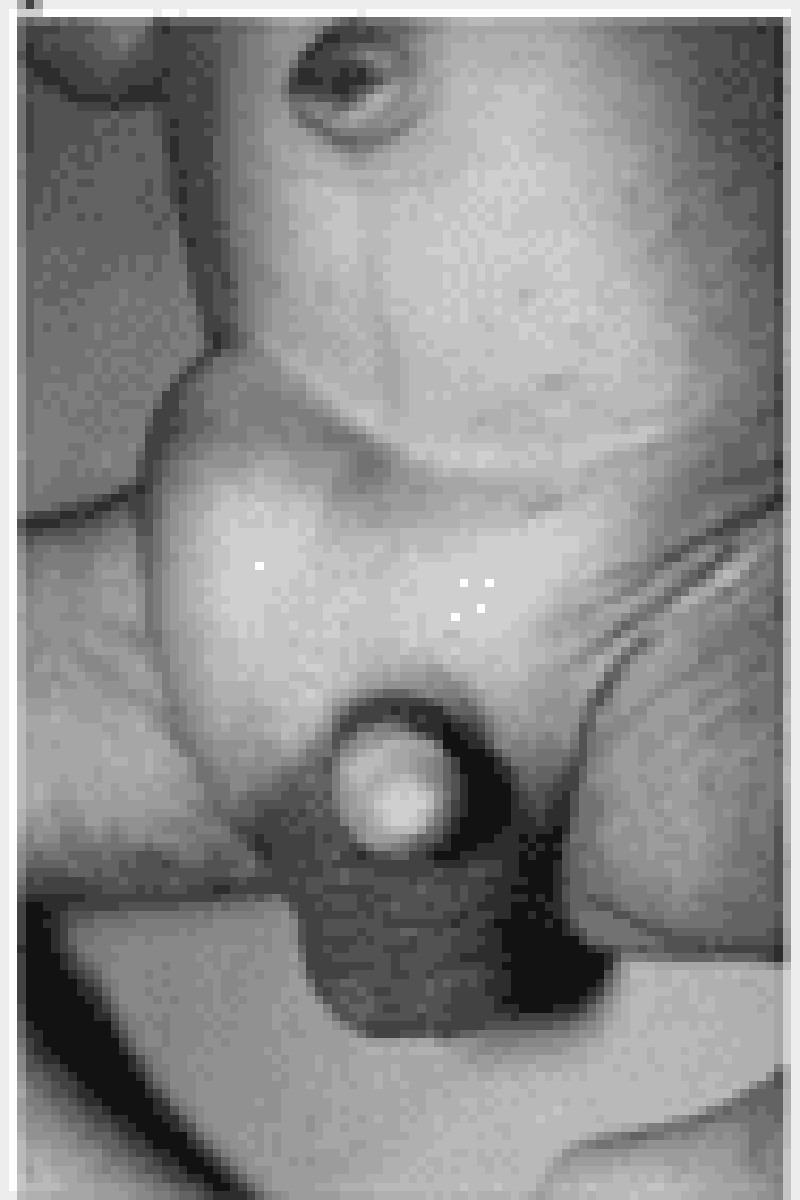
158) A 55-day-old infant born prematurely at 27 weeks of gestation is shown below. The swelling is not tender, firm, hot, or red, and it does not transil luminate. It seems to resolve with pressure, but returns when the infant cries or strains. Which of the following is the most appropriate course of action at this point?
A) Obtain a surgical consultation
B) Perform a needle aspiration
C) Order a barium enema
D) Order a KUB (plain radiographs of kidney, ureter, and bladder)
E) Observe the patient and reassure the patient and family
159) An 18-month-old infant is found with the contents of a bottle of drain cleaner in his mouth. Which of the following treatment options is most appropriate?
A) Immediate emesis
B) Endoscopic examination within the first 12 to 24 hours
C) Decontamination by activated charcoal
D) Neutralization by drinking a solution of the opposite pH
E) Have the patient drink copious amounts of milk or water
160) A 16-year-old male, despondent over a recent breakup, tries to commit suicide by taking an unknown quantity of an unknown material he found at home. He is brought to the emergency center by his parents within 30 minutes of the ingestion. For which of the following household materials and medications should he be given activated charcoal as part of his emergency center treatment?
A) Drain cleaner
B) Ethylene glycol
C) Bleach
D) Phenobarbital
E) Lithium
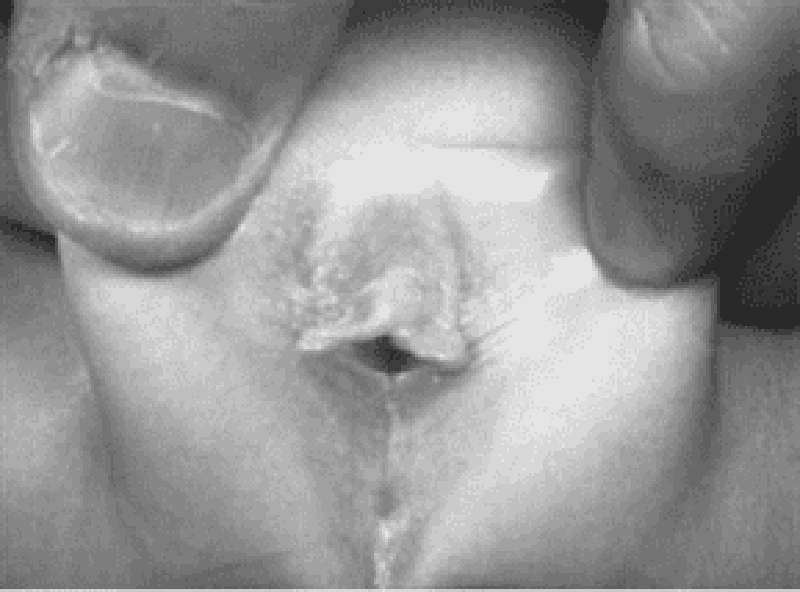
161) You are seeing a 4-year-old girl with the physical examination finding shown below. She has no significant past history. The most appropriate management is which of the following?
A) Surgical consultation for correction
B) Topical estrogen cream daily for a week
C) Topical steroid cream for a week
D) Referralto social services for possible sexual abuse
E) Karyotypestudies
162) At the 2-week checkup of a term female infant, the mother reports a grayish and sometimes bloody vaginal discharge since birth. The infant’s mother and grandmother are the only caretakers. Examination of the external genitalia reveals an intact hymen with a thin grayish mucous discharge. Which of the following is the most appropriate next step?
A) Parental reassurance
B) MRI of the brain
C) Ultrasound of the abdomen
D) Gonorrhea and chlamydial swabs
E) Referralto social services for possible sexual abuse
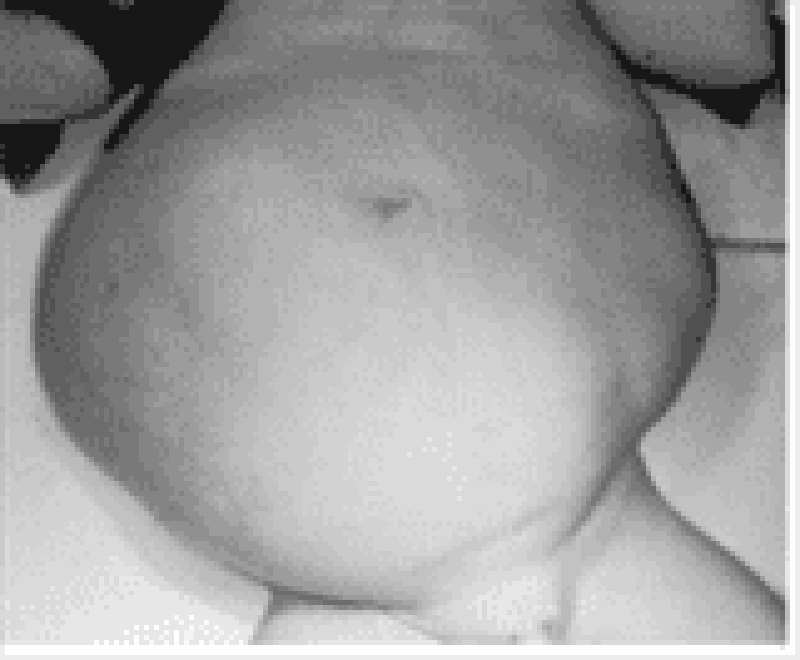
163) The delivery of a newborn boy is remarkable for oligohydramnios. The infant (pictured) is also noted to have undescended testes and clubfeet, and to be in respiratory distress. Which of the following is the most likely diagnosis to explain these findings?
A) Surfactant deficiency
B) Turner syndrome
C) Prune belly syndrome
D) Hermaphroditism
E) Congenital adrenal hyperplasia
164) A 17-year-old boy is brought to the emergency department by his parents with the complaint of coughing up blood. He is stabilized, and his hemoglobin and hematocrit levels are 11 mg/dL and 33%, respectively. During his hospitalization, he is noted to have systolic blood pressure persistently greater than 130 mm Hg and diastolic blood pressure greater than 90 mm Hg. His urinalysis is remarkable for hematuria and proteinuria. You are suspicious the patient has which of the following?
A) Hemolytic-uremic syndrome
B) Goodpasture syndrome
C) Nephrotic syndrome
D) Poststreptococcal glomerulonephritis
E) Renal vein thrombosis
165) A 1-year-old child presents with failure to thrive, frequent large voids of dilute urine, excessive thirst, and three episodes of dehydration not associated with vomiting or diarrhea. Over the years, other family members reportedly have had similar histories. Which of the following is the most likely diagnosis?
A) Water intoxication
B) Diabetes mellitus
C) Diabetes insipidus
D) Child abuse
E) Nephrotic syndrome
166) A 6-month-old infant has poor weight gain, vomiting, episodic fevers, and chronic constipation. Laboratory studies reveal a urinalysis with a pH of 8.0, specific gravity of 1.010, 1+ glucose, and 1+ protein. Urine anion gap is normal. Serum chemistries show a normal glucose and a normal albumin with a hyperchloremic metabolic acidosis. Serum phosphorus and calcium are low. What is the best diagnosis to explain these findings?
A) Renal tubular acidosis type 1
B) Renal tubular acidosis type 3
C) Renal tubular acidosis type 4
D) Hereditary Fanconi syndrome
E) Congenital nephrotic syndrome
167) The mother of a 2-year-old male child states that she has noticed white, cheeselike material arising from his foreskin and also that he cannot fully retract the foreskin behind the glans penis. Which of the following is the correct advice for this parent?
A) The child has phimosis and requires a circumcision.
B) The child has paraphimosis, and in addition to a circumcision, likely has an infection requiring topical antibiotics.
C) The child is normal.
D) The child likely has a previously undiagnosed hypospadias.
E) Ultrasound of kidneys, bladder, and ureters is indicated to check for unidentified associated defects.

168) After her first urinary tract infection, a 1-year-old has a voiding cystourethrogram with findings shown below. Which of the following is the most appropriate treatment option?
A) Low-dose daily antibiotics
B) Immediate surgical reimplantation of the ureters
C) Weekly urinalyses and culture
D) Diet low in protein
E) Early toilet training

169) Physical examination of a baby boy shortly after birth reveals a large bladder and palpable kidneys. The nurses note that he produces a weak urinary stream. A voiding cystourethrogram is shown below. He appears to be otherwise normal. Which of the following is the most likely diagnosis?
A) Ureteropelvic junction obstruction
B) Posterior urethral valve
C) Prune belly syndrome
D) Duplication of the collecting system
E) Horseshoekidney
170) A 5-year-old girl without past history of UTI is in the hospital on antibiotics for Escherichia coli pyelonephritis. She is still febrile after 4 days of appropriate antibiotics. A renal ultrasound revealed no abscess, but a focal enlargement of one of the lobes of the right kidney. CT of the abdomen reveals a wedge shaped area in the right kidney distinct from the normal tissue with minimal contrast enhancement. Appropriate management of this patient includes which of the following interventions?
A) Prolonged antibiotic therapy
B) Routine treatment with 10 to 14 days of antibiotics for pyelonephritis
C) Surgical consultation
D) Dimercaptosuccinic acid (DMSA) scan
E) Renal biopsy
171) A 4-year-old boy, whose past medical history is positive for three urinary tract infections, presents with a blood pressure of 135/90 mm Hg. He is likely to exhibit which of the following symptoms or signs?
A) Multiple cranial nerve palsy
B) Headache
C) Hyporeflexia
D) Increased urine output
E) Right ventricular hypertrophy
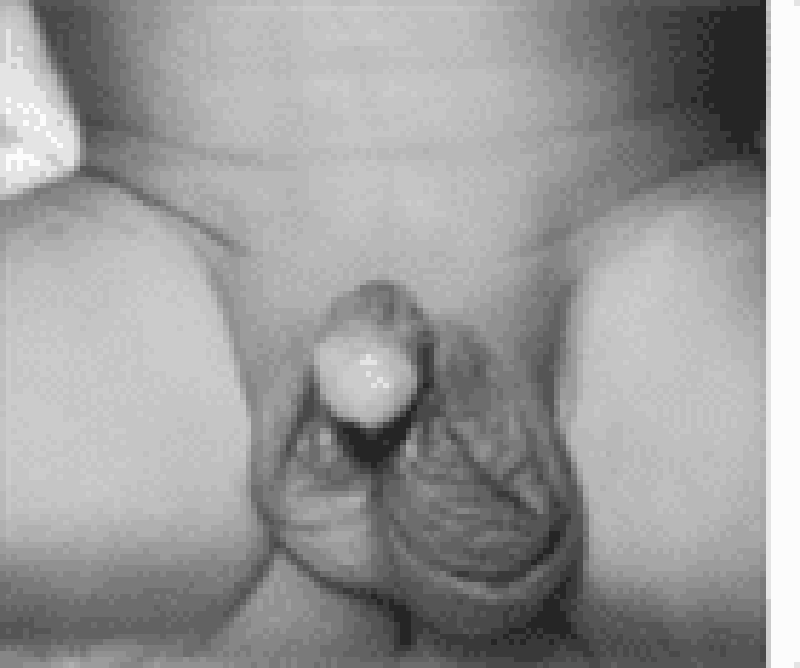
172) The 1-year-old boy in the photograph below, who recently had a circumcision, requires an additional operation on his genitalia that will probably eliminate his risk of which of the following?
A) Testicular malignancy
B) Decreased sperm count
C) Torsion of testes
D) Urinary tract infection
E) Epididymitis
173) A 6-week-old child is being evaluated for a fever of unknown etiology. As part of the laboratory evaluation, a urine specimen was obtained that grew E coli with a colony count of 2000/L. These findings would be definite evidence of a urinary tract infection if which of the following is true about the sampled urine?
A) It has a specific gravity of 1.008.
B) It is from a bag attached to the perineum of an uncircumcised boy.
C) It is from an ileal-loop bag.
D) It is from a suprapubic tap.
E) It is the first morning sample.

174) A boy has returned home from visiting his grandmother in a rural area. He spent most of his time swimming, playing in the yard, helping in the gardens, and chasing his Chihuahua; his grandma says “he was generally dirty!” He was noted 2 weeks ago to have “infected mosquito bites” on his neck and chin for which the local doctor had him just scrub with soap; a few remain and are shown in the photograph below. His mother brings him into the office with the complaint of dark urine, swelling around his eyes, and shortness of breath. You also find him to have hypertension and hepatomegaly. Which of the following is the most likely cause of his problem?
A) IgA nephropathy
B) Poststreptococcalglomerulonephritis
C) Idiopathic hypercalciuria
D) Pyelonephritis
E) Sexually transmitted disease
175) A 4-year-old boy and his family have recently visited a local amusement park. Several of the family members developed “gastroenteritis” with fever and diarrhea, but the 4- year-old’s stool was slightly different, as it contained blood. His mother reports that in the past 24 hours he developed pallor and lethargy; she relates that his face looks swollen and that he has been urinating very little. Laboratory evaluation reveals a hematocrit of 28% and a platelet count of 72,000/L. He has blood and protein in the urine. Which of the following diagnoses is most likely to explain these symptoms?
A) Henoch-Schönlein purpura
B) IgA nephropathy
C) Intussusception
D) Meckeldiverticulum
E) Hemolytic-uremic syndrome
176) A 6-year-old girl is brought to the emergency room because her urine is red. She has been healthy her whole life, and has recently returned from an outing with her grandmother to a local amusement park. Her urine dip for heme is positive, suggesting which of the following is a possibility?
A) Ingestion of blackberries
B) Ingestion of beets
C) Phenolphthalein catharsis
D) Presence of myoglobin
E) Ingestion of Kool-Aid
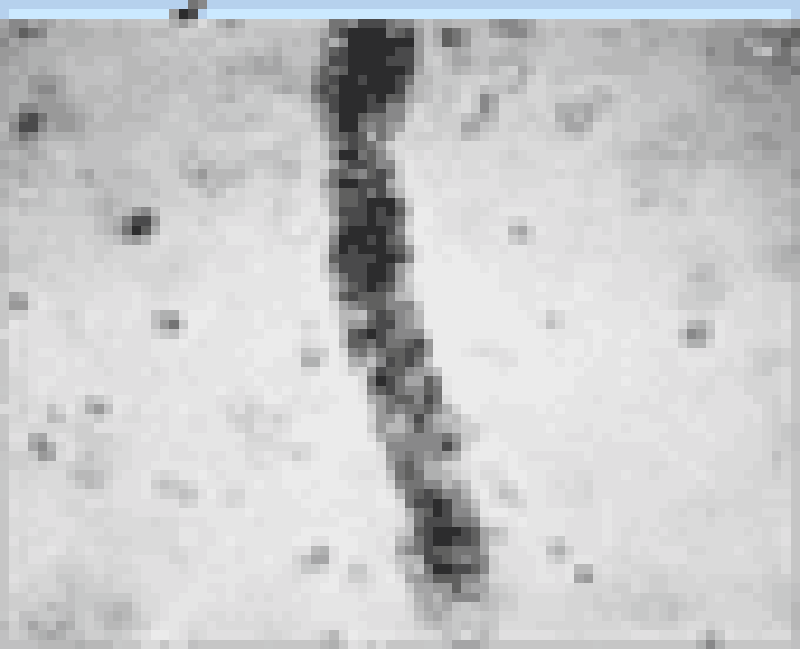
177) The photomicrograph below is of a urine specimen from a 15-year-old girl. She has had intermittent fever, malaise, and weight loss over the previous severalmonths. Recently she has developed swollen hands, wrists, and ankles, the pain of which seems out of proportion to the clinical findings. She also complains of cold extremities and has some ulceration of her distal digits. Which of the following laboratory tests is most likely to assist in the diagnosis of this condition?
A) Antibodies to nDNA and Sm nuclear antigens
B) Throat culture for group A -hemolytic streptococcus
C) Simultaneously acquired urine and serum bicarbonate levels
D) A urine culture
E) Erythrocyte sedimentation rate
178) A 12-year-old boy comes to the emergency department at midnight with a complaint of severe scrotalpain since 7 PM. There is no history of trauma. Which of the following is the most appropriate first step in management?
A) Order a surgical consult immediately.
B) Order a radioisotope scan as an emergency.
C) Order a urinalysis and Gram stain for bacteria.
D) Arrange for an ultrasound examination.
E) Order a Doppler examination.
179) The mother of a 2-year-old girl reports that her daughter complains of burning when she urinates and that she has foul-smelling discharge from her vagina. She has some slight staining on the front of her underwear, but denies fever, nausea, vomiting, or other constitutional signs. The child does not attend day care, and she has demonstrated no change in behavior. The physical examination is normal with an intact hymen, but the child’s vulva is reddened and with a malodorous scent noted. Her urinalysis and culture are normal. Management of this condition includes which of the following?
A) Complete genitourinary (GU) examination under general anesthesia
B) Progesterone cream to the affected area for a week
C) Advice to stop taking prolonged bubble baths
D) Mebendazole to eradicate pinworm infestation
E) Referralto social services for possible sexual abuse
180) A 7-year-old boy has cramping abdominal pain and a rash mainly on the back of his legs and buttocks as well as on the extensor surfaces of his forearms. Laboratory analysis reveals proteinuria and microhematuria. You diagnose Henoch-Schönlein, or anaphylactoid, purpura. In addition to his rash and abdominal pain, what other finding is he likely to have?
A) Chronic renal failure
B) Arthritis or arthralgia
C) Seizures
D) Unilateral lymphadenopathy
E) Bulbar nonpurulent conjunctivitis
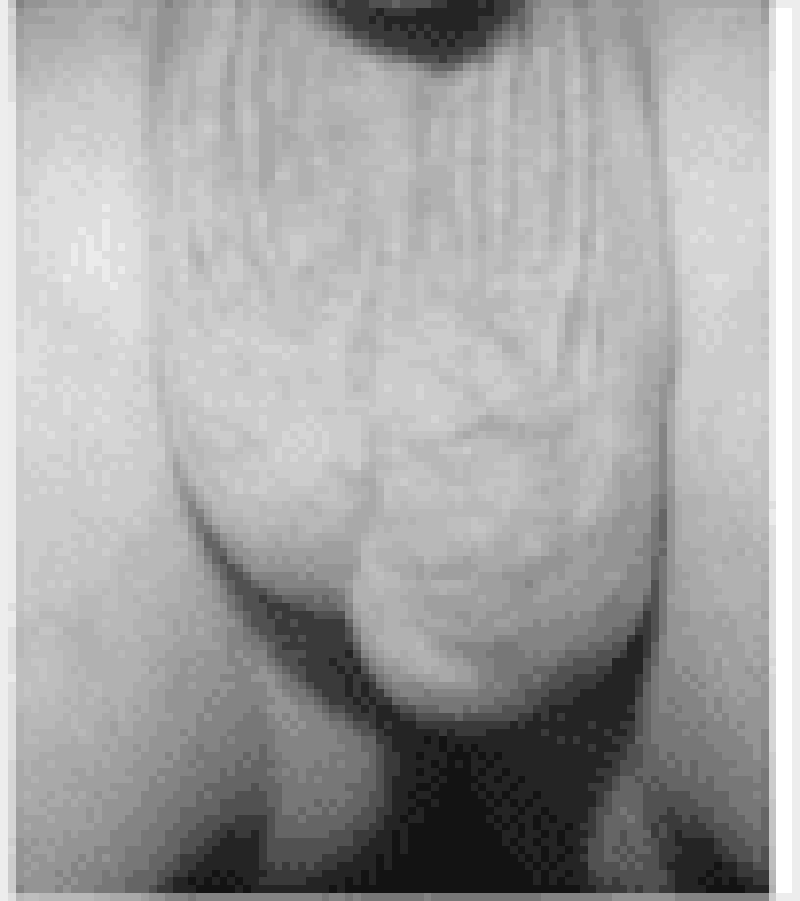
181) A 13-year-old boy’s scrotum is shown below. He complains of several months of swelling but no pain just above his left testicle. He is sexually active but states that he uses condoms. On physical examination, the area in question feels like a “bag of worms.” Which of the following is the most appropriate management for this condition?
A) Doppler flow study of testes
B) Radionuclide scan of testes
C) Urinalysis and culture
D) Ceftriaxone intramuscularly and doxycycline orally
E) Reassurance and education only at this time
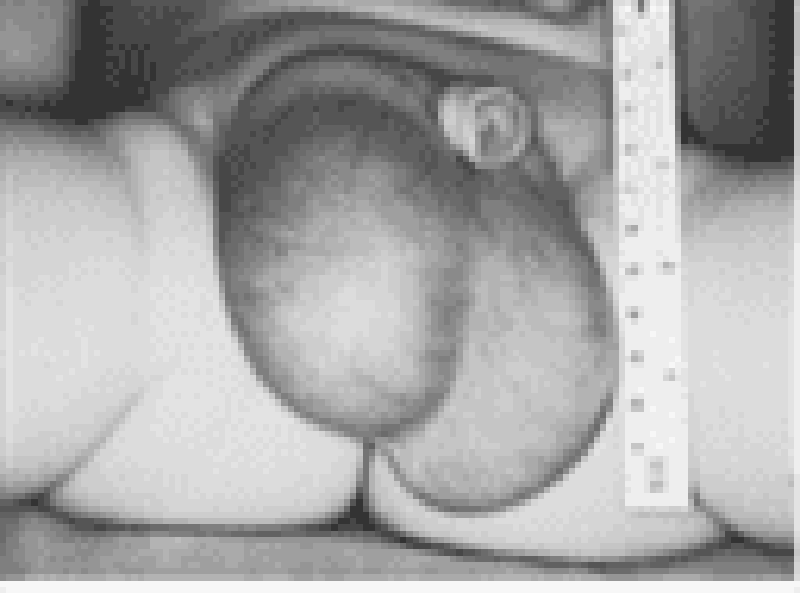
182) A 3-day-old infant’s scrotum is shown below. Palpation reveals a tense, fluid-filled area surrounding the right testicle. The scrotum transil luminates well, and the amount of fluid does not vary with mild pressure. Which of the following is the most appropriate approach to this condition?
A) Request a surgical consultation
B) Incision and drainage
C) Administer prophylactic antibiotics
D) Observe only
E) Perform a chromosome determination
183) A 2-year-old patient arrives late to your office with his father and a sign-language translator. They are very apologetic, but the father communicates that he had car trouble at his dialysis center and thus was late picking up the child from day care. The father is concerned about his child’s having intermittent red, bloody-looking urine. A gross inspection of the child’s urine in your office looks normal, but the dipstick demonstrates 3+ blood. Which of the following is the most likely cause of this child’s hematuria?
A) Alport syndrome
B) Berger nephropathy (IgA nephropathy)
C) Idiopathic hypercalciuria
D) Membranousglomerulopathy
E) Goodpasture syndrome
184) A 9-year-old boy comes to the office for a pre-participation physical examination for summer camp. His parents report that he still has episodes of bed-wetting. The boy’s father confides that he also had bed-wetting until he was 10. They are concerned about the bed- wetting, but they are more concerned about their son’s upcoming week at summer camp and that the other boys may harass him for wetting the bed. Which of the following statements about nocturnal enuresis is correct?
A) The condition is three times more common in girls than boys.
B) Most patients with this condition have a psychiatric illness as the cause.
C) Spontaneous cure rates are high regardless of therapy.
D) Family history of this condition is uncommon.
E) Short courses of desmopressin acetate (DDAVP) lead to permanent cure in 50% of cases.
185) A 21-year-old woman presents to the emergency room in active labor. She has had no prenatal care, but her last menstrual period was approximately 9 months prior. Her membranes are artificially ruptured, yielding no amniotic fluid. She delivers an 1800-g (4-lb) term infant who develops significant respiratory distress immediately at birth. The first chest radiograph on this infant demonstrates hypoplastic lungs. After this infant is stabilized, which of the following is the most appropriate next step for this infant?
A) Cardiac catheterization
B) Renal ultrasound
C) MRI of the brain
D) Liver and spleen scan
E) Upper GI
186) A 6-year-old child has had repeated episodes of otitis media. She undergoes an uneventful surgical placement of pressure-equalization (PE) tubes. In the recovery room she develops a fever of 40C (104F), rigidity of her muscles, and metabolic and respiratory acidosis. Which of the following is the most likely explanation for her condition?
A) Otitis media
B) Septicemia
C) Malignant hyperthermia
D) Dehydration
E) Febrile seizure
187) The 7-year-old boy now in your office was last seen 2 weeks ago with a mild viral upper respiratory tract infection. Today, however, he presents with fever, ataxia, weakness, headache, and emesis. In the office he has a 3 minutes left-sided tonic-clonic seizure. You send him to the hospital and order a magnetic resonance imaging (MRI) of the brain, the results of which show disseminated multifocal white matter lesions that enhance with contrast. This boy’s likely diagnosis is which of the following?
A) Multiple sclerosis
B) Acute disseminated encephalomyelitis
C) Malignant astrocytoma
D) Bacterialmeningitis
E) Neurocysticercosis

188) The examination of a child’s back is shown below. Evaluation with ultrasound of this lesion may demonstrate which of the following?
A) Epsteinpearl
B) Mongolian spot
C) Cephalohematoma
D) Omphalocele
E) Occult spina bifida
189) A 6-month-old child was noted to be normal at birth, but over the ensuing months you have been somewhat concerned about his slowish weight gain and his mild delay in achieving developmental milestones. The family calls you urgently at 7:00 AM noting that their child seems unable to move the right side of his body. Which of the following conditions might explain this child’s condition?
A) Phenylketonuria
B) Homocystinuria
C) Cystathioninuria
D) Maple syrup urine disease
E) Histidinemia
190) On a newborn boy’s first examination, you note a prominent occiput, a broad forehead, and an absent anterior fontanelle. The baby’s head is long and narrow. The remainder of the physical examination, including a careful neurological evaluation, is normal. You note that the baby was born via cesarean section for cephalopelvic disproportion. When you enter the mother’s room, the first question she asks is about her baby’s head shape.Which of the following is the most appropriate statement to the mother about this infant’s condition?
A) The condition is usually associated with other genetic defects.
B) The condition is usually associated with hydrocephalus.
C) Patients with this condition usually develop seizures.
D) The condition is associated with pituitary abnormalities.
E) The condition requires referral to a surgeon.
191) A 4-year-old child is observed to hold his eyelids open with his fingers and to close one eye periodically, especially in the evening. He has some trouble swallowing his food. He usually appears sad, although he laughs often enough. He can throw a ball, and he runs well. Which of the following is most likely to aid in the diagnosis?
A) Muscle biopsy
B) Creatine phosphokinase (CPK)
C) Effect of a test dose of edrophonium
D) Chest x-ray
E) Antinuclear antibodies (ANAs)
192) A 14-year-old girl with a history of seizures is admitted to the hospital with the diagnosis of status epilepticus. Her valproic acid level is in the therapeutic range. You arrange a 24-hour video electroencephalogram (EEG). During the EEG, she has severalepisodes of tonic and clonic movements with moaning and crying, with no loss of bowel or bladder control. The neurologist tells you that during the events the EEG had excessive muscle artifact but no epileptiform discharges. Which of the following treatments is the most appropriate for this condition?
A) Add a scheduled benzodiazepine for her muscular symptoms
B) Add carbamazepine to her current seizure medication
C) Increase her dose of valproic acid
D) Withdraw all seizure medications
E) Request a psychiatric evaluation
193) A previously healthy 7-year-old child suddenly complains of a headache and falls to the floor. When examined in the emergency room (ER), he is lethargic and has a left central facial weakness and left hemiparesis with conjugate ocular deviation to the right. Which of the following is the most likely diagnosis?
A) Hemiplegic migraine
B) Supratentorial tumor
C) Todd paralysis
D) Acute subdural hematoma
E) Acute infantile hemiplegia
194) A 5-month-old child was normal at birth, but the family reports that the child does not seem to look at them any longer. They also report the child seems to “startle” more easily than he had before. Testing of his white blood cells (WBCs) identifies the absence of -hexosaminidase A activity, confirming the diagnosis of which of the following?
A) Niemann-Pick disease, type A
B) Infantile Gaucher disease
C) Tay-Sachsdisease
D) Krabbe disease
E) Fabry disease
195) The family of a 4-year-old boy has just moved into your area. The child was recently brought to the emergency department (ED) for an evaluation of abdominal pain. Although appendicitis was ruled out in the ED and the child’s abdominal pain has resolved, the ED physician requested that the family follow up in your office to evaluate an incidental finding of an elevated creatine kinase. The family notes that he was a late walker (began walking independently at about 18 months of age), that he is more clumsy than their daughter was at the same age (especially when trying to hold onto small objects), and that he seems to be somewhat sluggish when he runs, climbs stairs, rises from the ground after he sits, and rides his tricycle. A thorough history and physical examination are likely to revealwhich of the following?
A) Hirsutism
B) Past seizure activity
C) Proximal muscle atrophy
D) Cataracts
E) Enlarged gonads
196) A 9-year-old girl is brought by her sister to her pediatrician with the complaint of severe, intermittent headaches for the past severalmonths, one of which resulted in her going to the ER. The physical examination today, including a careful neurologic examination, is normal. The headache is diffuse, throbbing, lasts several hours, and is not associated with vomiting or other symptoms. The child cannot feel the headaches coming on; they appear on all days of the week; and usually the headaches are gone when she awakens from a nap. The child reports that she is doing well in school, plays clarinet in the school band, and has “lots of friends.” The sister is not sure, but she thinks their father, who lives in another state, may have headaches. The most likely explanation for this girl’s headache is which of the following?
A) Migraine
B) Tension headache
C) Brain tumor
D) Sinusitis
E) Fungal meningitis
197) Examination of the cerebrospinal fluid (CSF) of an 8-year-old, mildly febrile child with nuchal rigidity and intermittent stupor shows the following: WBCs 85/L (all lymphocytes), negative Gram stain, protein 150 mg/dL, and glucose 15 mg/dL. A computed tomographic (CT) scan with contrast shows enhancement of the basal cisterns by the contrast material. Which of the following is the most likely diagnosis?
A) Tuberous sclerosis
B) Tuberculous meningitis
C) Stroke
D) Acute bacterial meningitis
E) Pseudotumor cerebri
198) An irritable 6-year-old child has a somewhat unsteady but nonspecific gait. Physical examination reveals a very mild left facial weakness, brisk stretch reflexes in all four extremities, bilateral extensor plantar responses (Babinski reflex), and mild hypertonicity of the left upper and lower extremities; there is no muscular weakness. Which of the following is the most likely diagnosis?
A) Pontineglioma
B) Cerebellar astrocytoma
C) Tumor of the right cerebralhemisphere
D) Subacute sclerosing panencephalitis
E) Progressivemultifocalleukoencephalopathy
199) A 2-year-old boy has been doing well despite his diagnosis of tetralogy of Fallot. He presented to an outside ER a few days ago with a complaint of an acute febrile illness for which he was started on a “pink antibiotic.” His mother reports that for the past 12 hours or so he has had a headache and is more lethargic than normal. On your examination he seems to have a severe headache, nystagmus, and ataxia. Which of the following would be the most appropriate first test to order?
A) Urine drug screen
B) Blood culture
C) Lumbar puncture
D) CT or MRI of the brain
E) Stat echocardiogram
200) A 6-year-old child is hospitalized for observation because of a short period of unconsciousness after a fall from a playground swing. He has developed unilateral pupillary dilatation, focal seizures, recurrence of depressed consciousness, and hemiplegia. Which of the following is the most appropriate management at this time?
A) Spinal tap
B) CT scan
C) Rapid fluid hydration
D) Naloxone
E) Gastric decontamination with charcoal
201) A 6-year-old boy is seen in the office for evaluation of polyuria. Further questioning reveals severalmonths of headache with occasional emesis. Your physical examination reveals a child who is less than 5% for weight. He has mild papilledema. His glucose is normal, and his first urine void specific gravity after a night without liquids is 1.005 g/mL. Which of the following might also be expected to be seen in this patient?
A) Sixth nerve palsy
B) Unilateral cerebellar ataxia
C) Unilateral pupillary dilatation
D) Unilateral anosmia
E) Bitemporal hemianopsia
202) A 6-year-old boy had been in his normal state of good health until a few hours prior to presentation to the ER room. His mother reports that he began to have difficulty walking, and she noticed that he was falling and unable to maintain his balance. Which of the following is the most likely cause for his condition?
A) Drug intoxication
B) Agenesis of the corpus callosum
C) Ataxiatelangiectasia
D) Muscular dystrophy
E) Friedreich ataxia
203) A 9-year-old child has developed headaches that are more frequent in the morning and are followed by vomiting. Over the previous few months, his family has noted a change in his behavior (generally more irritable than usual) and his school performance has begun to drop. Imaging of this child is most likely to reveal a lesion in which of the following regions?
A) Subtentorial
B) Supratentorial
C) Intraventricular
D) Spinal canal
E) Peripheral nervous system
204) A young infant is noted to have developed constipation over the past week, and then facial diplegia and difficulty sucking and swallowing. The child has been colicky, and the maternal grandmother has been treating the child with a mixture of weak tea, rice water, and honey. Which of the following disorders is the most likely culprit in this child?
A) Infantile spinal muscular atrophy
B) Myastheniagravis
C) Congenital myotonic dystrophy
D) Duchenne muscular dystrophy
E) Botulism
205) At birth, an infant is noted to have an abnormal neurologic examination. Over the next few weeks he develops severe progressive centralnervous system (CNS) degeneration, an enlarged liver and spleen, macroglossia, coarse facial features, and a cherry-red spot in the eye. Which of the following laboratory findings most likely explains this child’s problem?
A) Reduced serum hexosaminidase A activity
B) Deficient activity of acid B-galactosidase
C) Defective gene on the X chromosome
D) Complete lack of acid -galactosidase activity
E) Deficientactivityofgalactosyl-3-sulfate-ceramidesulfatase(cerebrosidesulfatase)
206) The parents of a 2-year-old bring her to the emergency center after she had a seizure. Although the parents report she was in a good state of health, the vital signs in the emergency center reveala temperature of 39C (102.2F). She is now running around the room. Which part of the story would suggest the best outcome in this condition?
A) A CSF white count of 100/L.
B) Otitis media on examination.
C) The seizure lasted 30 minutes.
D) The child was born prematurely with an intraventricular hemorrhage.
E) The family reports the child to have had right-sided tonic-clonic activity only.
207) About 12 days after a mild upper respiratory infection, a 12-year-old boy complains of weakness in his lower extremities. Over severaldays, the weakness progresses to include his trunk. On physical examination, he has the weakness described and no lower extremity deep tendon reflexes, muscle atrophy, or pain. Spinal fluid studies are notable for elevated protein only. Which of the following is the most likely diagnosis in this patient?
A) Bell palsy
B) Muscular dystrophy
C) Guillain-Barré syndrome
D) Charcot-Marie-Tooth disease
E) Werdnig-Hoffmann disease
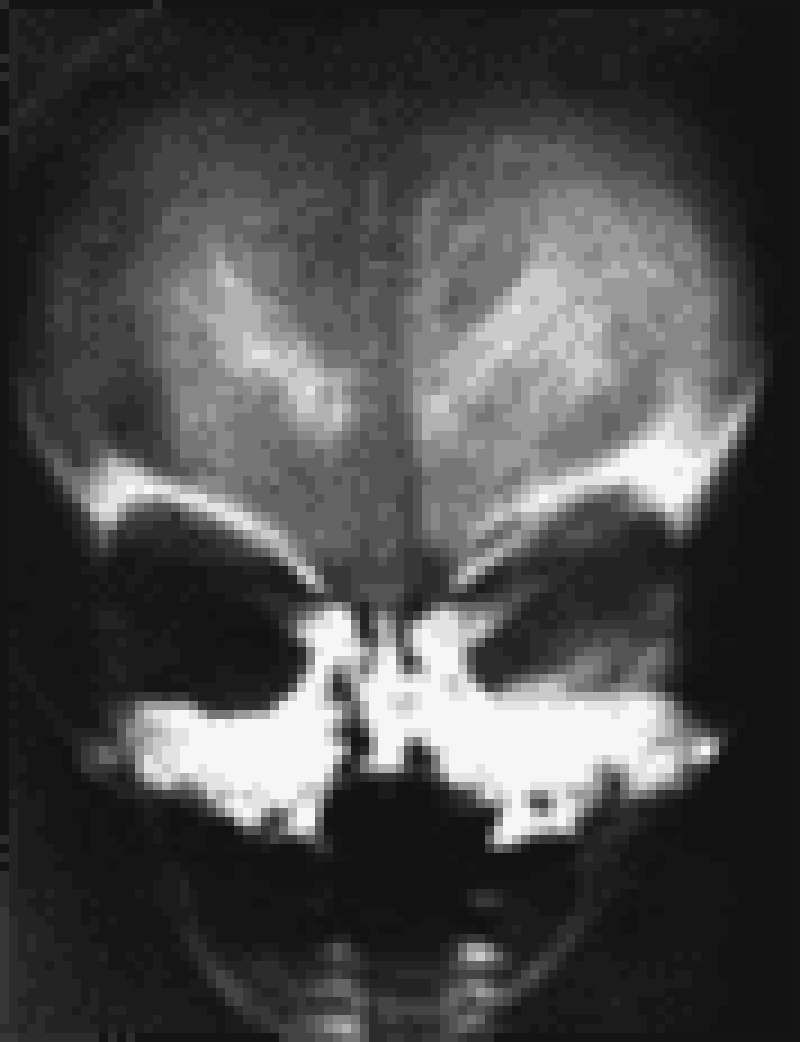
208) The developmentally delayed 6-month-old child in the picture below had intrauterine growth retardation (including microcephaly), hepatosplenomegaly, prolonged neonatal jaundice, and purpura at birth. The calcific densities in the skull x-ray shown are likely the result of which of the following?
A) Congenital cytomegalovirus (CMV) infection
B) Congenital toxoplasmosis infection
C) Congenital syphilis infection
D) Tuberculous meningitis
E) Craniopharyngioma
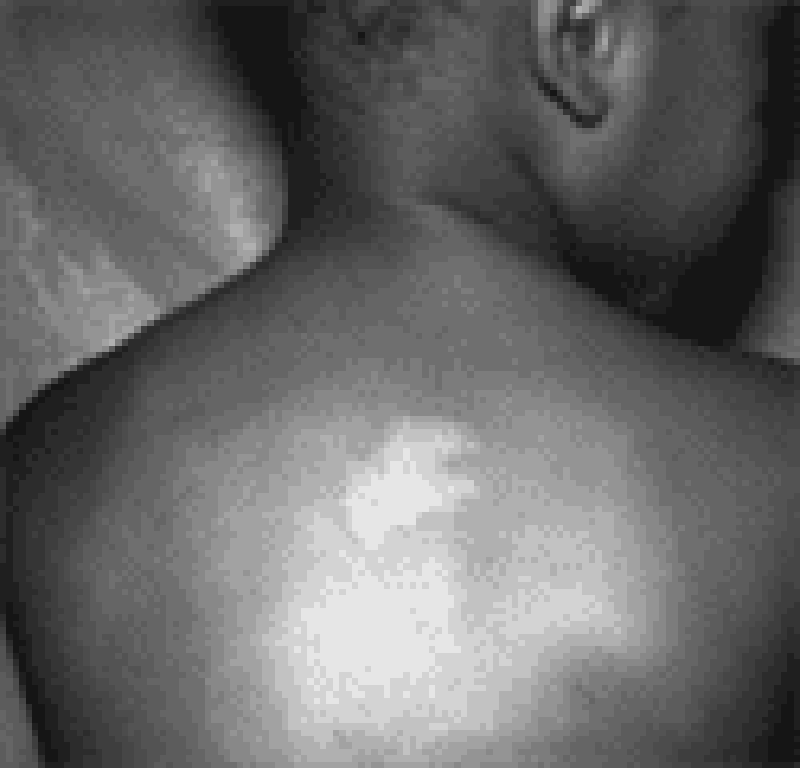
209) The infant pictured below develops infantile spasms. Which of the following disorders is most likely to be affecting this infant?
A) Neurofibromatosis
B) Tuberous sclerosis
C) Incontinentia pigmenti
D) Pityriasis rosea
E) Psoriasis
210) A newborn infant has respiratory distress and trouble feeding in the nursery. The mother has no significant medical history, but the pregnancy was complicated by decreased fetal movement. On physical examination, you note that aside from shallow respirations and some twitching of the fingers and toes, the infant is not moving, and is very hypotonic. In the mouth there is pooled saliva and you note tongue fasciculations. Deep tendon reflexes are absent. Spinal fluid is normal. Appropriate statements about this condition include which of the following statements?
A) The condition is caused by the absence of the muscle cytoskeletal protein dystrophin.
B) The condition is caused by the degeneration of anterior horn cells in the spinal cord.
C) The condition is caused by the antibodies that bind the acetylcholine receptor at the postsynaptic muscle membrane.
D) The condition is caused by progressive autoimmune demyelination.
E) The condition is caused by birth trauma.
211) A 3-year-old boy’s parents complain that their child has difficulty walking. The child rolled, sat, and first stood at essentially normal ages and first walked at 13 months of age. Over the past severalmonths, however, the family has noticed an increased inward curvature of the lower spine as he walks and that his gait has become more “waddling” in nature. On examination, you confirm these findings and also notice that he has enlargement of his calves. Which of the following is the most likely diagnosis?
A) Occult spina bifida
B) Muscular dystrophy
C) Brain tumor
D) Guillain-Barrésyndrome
E) Botulism
212) Your 6-year-old son awakens at 1:00 AM screaming. You note that he is hyperventilating, is tachycardic, and has dilated pupils. He cannot be consoled, does not respond, and is unaware of his environment. After a few minutes, he returns to normal sleep. He recalls nothing the following morning. Which of the following is the most likely diagnosis?
A) Seizure disorder
B) Night terrors
C) Drug ingestion
D) Psychiatric disorder
E) Migraine headache
213) A previously healthy 16-year-old girl presents to the emergency center with the complaint of “falling out.” She was with her friends at a local fast food restaurant when she felt faint and, according to her friends, lost consciousness for about a minute. There was no seizure activity noted, but the friends did notice her arms twitching irregularly. She is now acting normally. She denies chest pain or palpitations, and her electrocardiogram (ECG) is normal. Further management of this patient should include which of the following?
A) Obtain an EEG
B) Refer to a child psychiatrist
C) Begin -blocker therapy
D) Encourage adequate fluid and salt intake
E) Obtain serum and urine drug screens
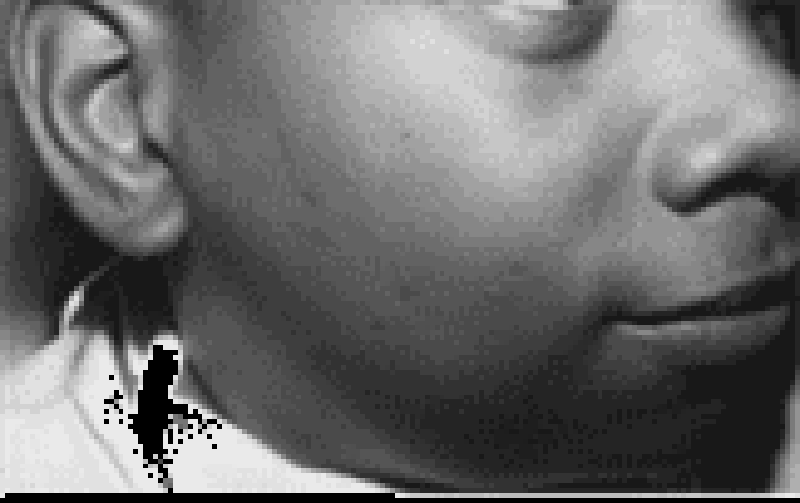
214) A 10-year-old patient (pictured below) calls his parents from summer camp to state that he has had fever, muscular pain (especially in the neck), headache, and malaise. He describes the area from the back of his mandible toward the mastoid space as being full and tender and that his earlobe on the affected side appears to be sticking upward and outward. Drinking sour liquids causes much pain in the affected area. When his father calls your office, you remind him that he had refused immunizations for his child on religious grounds. Which of the following preventable diseases has this child acquired?
A) Mumps
B) Varicella
C) Rubella
D) Measles
E) Diphtheria
215) A 2-month-old child of an HIV-positive mother is followed in your pediatric practice. Which of the following therapies should be considered for this child?
A) Monthly evaluation for Kaposi sarcoma
B) Prophylaxis against Pneumocystis jiroveci pneumonia (Pneumocystis carinii)
C) Vitamin C supplementation
D) Oralpolio virus vaccine
E) Bone marrow transplantation
216) A 10-month-old infant on long-term aspirin therapy for Kawasaki disease develops sudden onset of high fever, chills, diarrhea, and irritability. A rapid swab in your office identifies influenza A, adding her to the long list of influenza patients you have seen this December. Over the next few days, she slowly improves and becomes afebrile. However, 5 days after your last encounter you hear from the hospital that she has presented to the emergency center obtunded and posturing with evidence of liver dysfunction. Which of the following statements about her current condition is correct?
A) With proper supportive care, the overall mortality rate is low.
B) With her progressiveliver dysfunction, increased total serum bilirubin is anticipated.
C) Administration of N-acetylcysteine is first-line therapy.
D) Seizures are uncommon with this condition.
E) Death is usually associated with increased intracranial pressures and herniation.
217) An 18-month-old child presents to the emergency center having had a brief, generalized tonic-clonic seizure. He is now postictal and has a temperature of 40C (104F). During the lumbar puncture (which ultimately proves to be normal), he has a large, watery stool that has both blood and mucus in it. Which of the following is the most likely diagnosis in this patient?
A) Salmonella
B) Enterovirus
C) Rotavirus
D) Campylobacter
E) Shigella
218) A 2-year-old child is admitted to your hospital team. The child’s primary care doctor has been following the child for severaldays and has noted her to have had high fever, peeling skin, abdominal pain, and a bright red throat. You are concerned because two common pediatric problems that could explain this child’s condition have overlapping presenting signs and symptoms. Which of the following statements comparing these two diseases in your differential is true?
A) Neither has cardiac complications.
B) Serologic tests are helpful in diagnosing both.
C) Only one of the diseases has mucocutaneous and lymph node involvement.
D) Pharyngealculture aids in the diagnosis of one of the conditions.
E) A specific antibiotic therapy is recommended for one of the conditions, but only supportive care is recommended for the other.
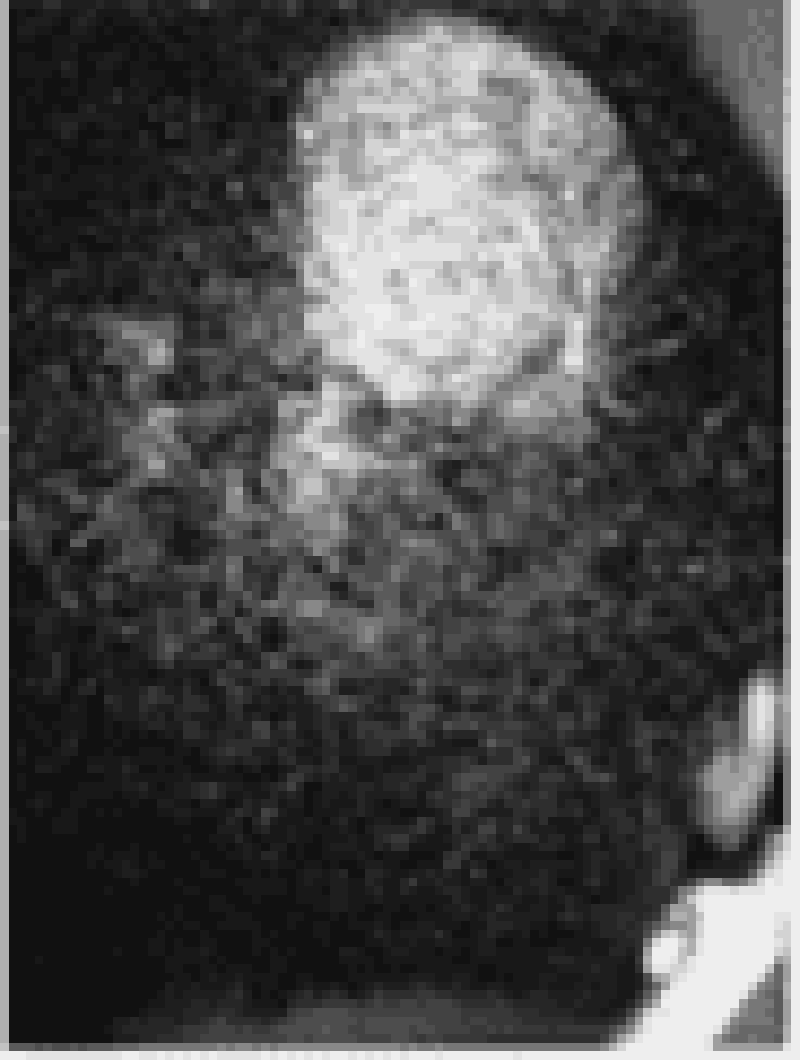
219) A patient with hair loss is shown below. The lesion does not fluoresce with a Wood lamp and has not responded well to a variety of topical agents.The lesion is boggy, is spreading, and has tiny pinpoint black dots throughout. Which of the following is the most likely diagnosis?
A) Traction alopecia from tight hair braids
B) Infection with Trichophyton tonsurans
C) Alopecia areata
D) Biotinidasedeficiency
E) Hypothyroidism
220) An 8-year-old sickle-cell patient arrives at the emergency room (ER) in respiratory distress. Over the previous severaldays, the child has become progressively tired and pale. The child’s hemoglobin concentration in the ER is 3.1 mg/dL. Which of the following viruses commonly causes such a clinical picture?
A) Roseola
B) Parvovirus B19
C) Coxsackie A16
D) Echovirus11
E) Cytomegalovirus
221) A 10-year-old boy was healthy until about 10 days ago when he developed 7 days of fever, chills, severe muscle pain, pharyngitis, headache, scleral injection, photophobia, and cervical adenopathy. After 7 days of symptoms he seemed to get better, but yesterday he developed fever, nausea, emesis, headache and mild nuchal rigidity. Cerebrospinal fluid (CSF) shows 200 white blood cells (WBC) per microliter (all monocytes) and an elevated protein. Correct statements about this infection include which of the following?
A) The condition is obtained from arthropod vectors
B) CNS involvement is uncommon
C) Most cases are mild or subclinical
D) Appropriate treatment includes intravenous (IV) immune globulin (IVIG) and aspirin
E) Hepatic and renal involvement occurs in the majority of cases
222) A previously healthy 8-year-old boy has a 3-week history of low-grade fever of unknown source, fatigue, weight loss, myalgia, and headaches. On repeated examinations during this time, he is found to have developed a heart murmur, petechiae, and mild splenomegaly. Which of the following is the most likely diagnosis?
A) Rheumatic fever
B) Kawasakidisease
C) Scarlet fever
D) Endocarditis
E) Tuberculosis
223) A 15-month-old boy is brought to the ER because of fever and a rash. Six hours earlier he was fine, except for tugging on his ears; another physician diagnosed otitis media and prescribed amoxicillin. During the interim period, the child has developed an erythematous rash on his face, trunk, and extremities. Some of the lesions, which are of variable size, do not blanch on pressure. The child is now very irritable, and he does not interact well with the examiner. Temperature is 39.5C (103.1F). He continues to have injected, immobile tympanic membranes, but you are concerned about his change in mental status. Which of the following is the most appropriate next step in the management of this infant?
A) Begin administration of IV ampicillin
B) Begin diphenhydramine
C) Discontinue administration of ampicillin and begin trimethoprim with sulfamethoxazole
D) Perform bilateral myringotomies
E) Perform a lumbar puncture
224) The 3-year-old sister of a newborn baby develops a cough diagnosed as pertussis by nasopharyngeal culture. The mother gives a history of having been immunized as a child. Which of the following is a correct statement regarding this clinical situation?
A) The mother has no risk of acquiring the disease because she was immunized.
B) Hyperimmune globulin is effective in protecting the infant.
C) The risk to the infant depends on the immune status of the mother.
D) Erythromycin should be administered to the infant.
E) The 3-year-old sister should be immediately immunized with an additional dose of pertussis vaccine.
225) A 14-year-old boy is seen in the ER because of a 3-week history of fever between 38.3C and 38.9C (101F and 102F), lethargy, and a 2.7-kg (6-lb) weight loss. Physical examination reveals marked cervical and inguinal adenopathy, enlarged tonsils with exudate, small hemorrhages on the soft palate, a WBC differential that has 50% lymphocytes (10% atypical), and a palpable spleen 2 cm below the left costal margin. Which of the following therapies should be initiated?
A) Initiation of zidovudine
B) IV acyclovir
C) IV infusion of immunoglobulins and high-dose aspirin
D) Intramuscular penicillin
E) Avoidance of contact sports
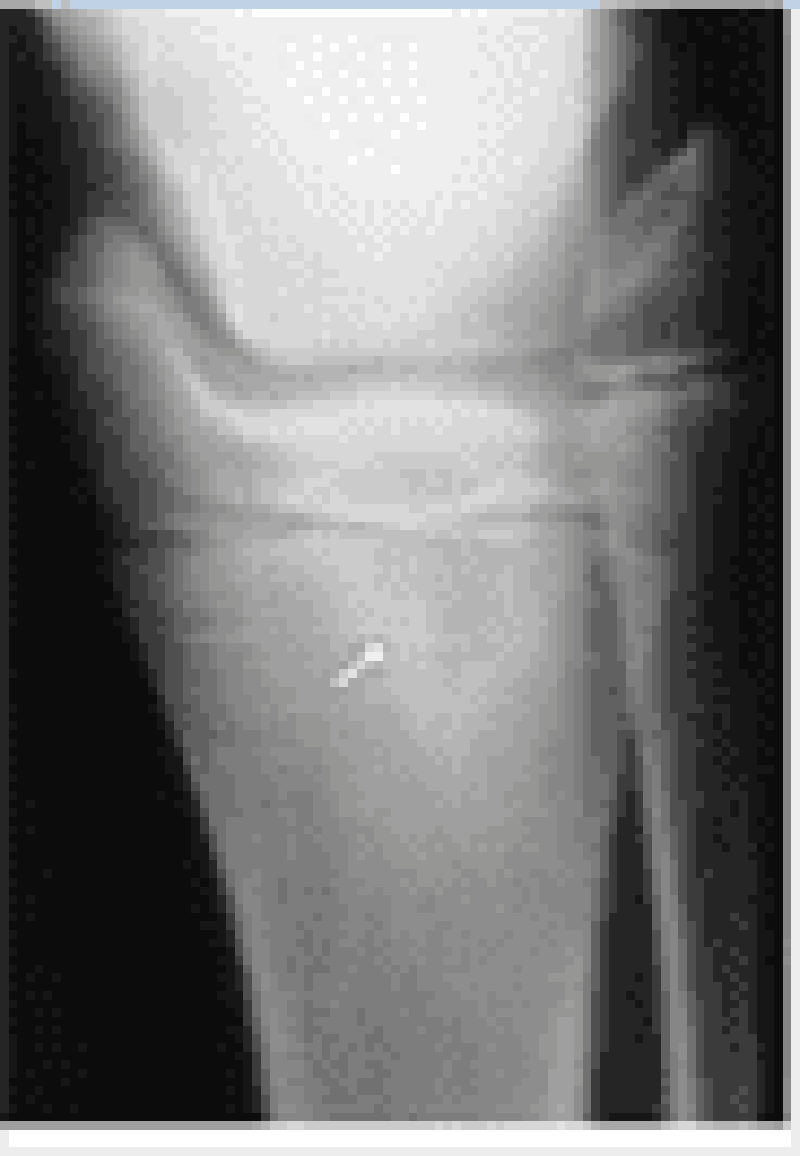
226) A 2-year-old child is seen in the emergency center with a 10-day complaint of fever and a limp. The child has an elevated erythrocyte sedimentation rate (ESR) and the radiograph shown below. Which of the following statements about this child’s condition is correct?
A) It is most commonly caused by Streptococcus pyogenes.
B) It can arise following development of deep cellulitis.
C) It usuallyresultsin tendernessin the region of infection that is diffuse, notlocalized.
D) It causes diagnostic radiographic changes on plain films within 48 hours of the beginning of symptoms.
E) It requires antibiotic therapy usually for 10 to 14 days.
227) A 16-day-old infant presents with fever, irritability, poor feeding, and a bulging fontanelle. Spinal fluid demonstrates gram-positive cocci. Which of the following is the most likely diagnosis?
A) Listeria monocytogenes
B) Group A streptococci
C) Group B streptococci
D) Streptococcus pneumoniae
E) Staphylococcus aureus
228) A 16-year-old boy presents to the emergency center with a 2-day history of an abscess with spreading cellulitis. While in the emergency center, he develops a high fever, hypotension, and vomiting with diarrhea. On examination you note a diffuse erythematous macular rash, injected conjunctiva and oral mucosa, and a strawberry tongue. He is not as alert as when he first arrived. This rapidly progressive symptom constellation is likely caused by which of the following disease processes?
A) Kawasakidisease
B) TSST-1–secreting S aureus
C) Shiga toxin–secreting Escherichia coli
D) -Toxin–secreting Clostridium perfringens
E) Neurotoxin-secreting Clostridium tetani
229) A 14-month-old infant suddenly develops a fever of 40.2C (104.4F). Physical examination shows an alert, active infant who drinks milk eagerly. No physical abnormalities are noted. The WBC count is 22,000/L with 78% polymorphonuclear leukocytes, 18% of which are band forms. Which of the following is the most likely diagnosis?
A) Pneumococcal bacteremia
B) Roseola
C) Streptococcosis
D) Typhoid fever
E) Diphtheria
230) A 21-year-old woman has just delivered a term infant. She has had only one visit to her obstetrician, and that was at about 6 weeks of pregnancy. She provides her laboratory results from that visit. The delivered infant is microcephalic, has cataracts, a heart murmur, and hepatosplenomegaly. Your further evaluation of the child demonstrates hrombocytopenia,mild hemolytic anemia, and, on the echocardiogram, patent ductus arteriosus and peripheral pulmonary artery stenosis. Which of the following maternal laboratory tests done at 6 weeks gestation is likely to explain the findings in this child?
A) Positive hepatitis B surface antibody
B) Positive rapid plasma reagin (RPR) with negative MicrohemagglutinationTreponemapallidum test (MHATP)
C) Negative rubella titer
D) Negative triple screen
E) Positive varicella titer
231) The parents of a 7-day-old infant bring her to your office for a swollen eye. Her temperature has been normal, but for the last 2 days she has had progressive erythema and swelling over the medial aspect of the right lower lid near the punctum. Her sclera and conjunctiva are clear. Gentle pressure extrudes a whitish material from the punctum. Which of the following ophthalmic conditions is the correct diagnosis?
A) Chalazion
B) Dacryocystitis
C) Preseptalcellulitis
D) Hyphema
E) Congenital Sjögren syndrome
232) The parents of a 3-year-old patient followed in your clinic recently took their child on quickly planned 5-day trip to Africa to visit an ill grandparent. Everyone did well on the trip, but since their return about 10 days ago the boy has been having intermittent, spiking fevers associated with headache, sweating, and nausea. The parents had not been too concerned since he was relatively well, except for being tired, between the fevers. Today, however, they feel that he looks a bit pale and his eyes appear “yellow.” Which of the following is likely to reveal the source of his problem?
A) Hepatitis A IgG and IgM titers
B) Complete blood count (CBC) with smear
C) Hemoglobin electrophoresis
D) Tuberculosis skin test
E) Hepatitis B IgG and IgM titers

233) The child shown below presents with a 3-day history of malaise, fever to 41.1C (106F), cough, coryza, and conjunctivitis. He then develops the erythematous, maculopapular rash pictured. He is noted to have white pinpoint lesions on a bright red buccal mucosa in the area opposite his lower molars. Which of the following is the most likely diagnosis?
A) Parvovirus
B) Rubella
C) Herpes
D) Rubeola
E) Varicella
234) A 14-year-old girl awakens with a mild sore throat, low-grade fever, and a diffuse maculopapular rash. During the next 24 hours, she develops tender swelling of her wrists and redness of her eyes. In addition, her physician notes mild tenderness and marked swelling of her posterior cervical and occipital lymph nodes. Four days after the onset of her illness, the rash has vanished. Which of the following is the most likely diagnosis?
A) Rubella
B) Rubeola
C) Roseola
D) Erythema infectiosum
E) Erythema multiforme
235) A 4-year-old child presents in the clinic with an illness notable for swelling in front of and in back of the ear on the affected side, as well as altered taste sensation. Correct statements about this condition include which of the following?
A) Arthritis is a common presenting complaint in children.
B) The disease could have been prevented by prior immunization with killed wholecell vaccine.
C) Involvement of the central nervous system (CNS) may occur 10 days after the resolution of the swelling.
D) Orchitis can occur and is almost exclusively seen in prepubertal males.
E) Subendocardial fibroelastosis is a common complication in a child of this age.
236) A bat is found in the bedroom of a 4-year-old patient while the boy is sleeping. The family and the patient deny close contact with or bites from the bat. Which of the following is a correct statement regarding this situation?
A) Therapy is only required if the patient shows signs of rabies infection.
B) Bats are not a natural reservoir for rabies virus; no therapy is required.
C) The patient should be started on the rabies vaccine series.
D) The patient needs immediate treatment with acyclovir.
E) The patient needs immediate treatment with ribavirin.
237) An 8-year-old Cub Scout who returned from an outing 9 days ago is brought to the clinic with the rapid onset of fever, headache, muscle pain, and rash. The maculopapular rash began on the flexor surfaces of the wrist and has become petechial as it spread inward to his trunk. Which of the following is the most likely diagnosis?
A) Lyme disease
B) Tularemia
C) Measles
D) Toxic shock syndrome
E) Rocky Mountain spotted fever
238) The parents of a 7-month-old boy arrive in your office with the child and a stack of medical records for a second opinion. The boy first started having problems after his circumcision in the nursery when he had prolonged bleeding. Studies were sent at the time for hemophilia, but factor VIII and IX activity were normal. At 2 months he developed bloody diarrhea, which his doctor assumed was a milk protein allergy and changed him to soy; his parents note he still has occasional bloody diarrhea. He has seen a dermatologist severaltimes for eczema, and he has been admitted to the hospital twice for pneumococcal bacteremia. During both admissions, the parents were told that the infant’s platelet count was low, but they have yet to attend the hematology appointment arranged for them. The child’s WBC count and differential were normal. Which of the following is the most likely diagnosis in this child?
A) Idiopathic thrombocytopenic purpura
B) Wiskott-Aldrich syndrome
C) Acute lymphocytic leukemia
D) Adenosine deaminase deficiency
E) Partial thymic hypoplasia
239) A 10-year-old boy from the Connecticut coast is seen because of discomfort in his right knee. He had a large, annular, erythematous lesion on his back that disappeared 4 weeks prior to the present visit. His mother recalls pulling a small tick off his back. Which of the following is a correct statement about this child’s likely illness?
A) Thetickwasprobablya Dermacentor andersoni.
B) The disease is caused by a rickettsial agent that is transmitted by the bite of a tick.
C) In addition to skin and joint involvement, CNS and cardiac abnormalities may be present
D) Therapy with antibiotics has little effect on the resolution of symptoms.
E) The pathognomonic skin lesion is required for diagnosis.
240) Two weeks ago, a 5-year-old boy developed diarrhea, which has persisted to the present time despite dietary management. His stools have been watery, pale, and frothy. He has been afebrile. Microscopic examination of his stools is likely to show which of the following?
A) Salmonella sonnei
B) Enterobius vermicularis
C) Sporothrix schenckii
D) Toxoplasmagondii
E) Cryptosporidium
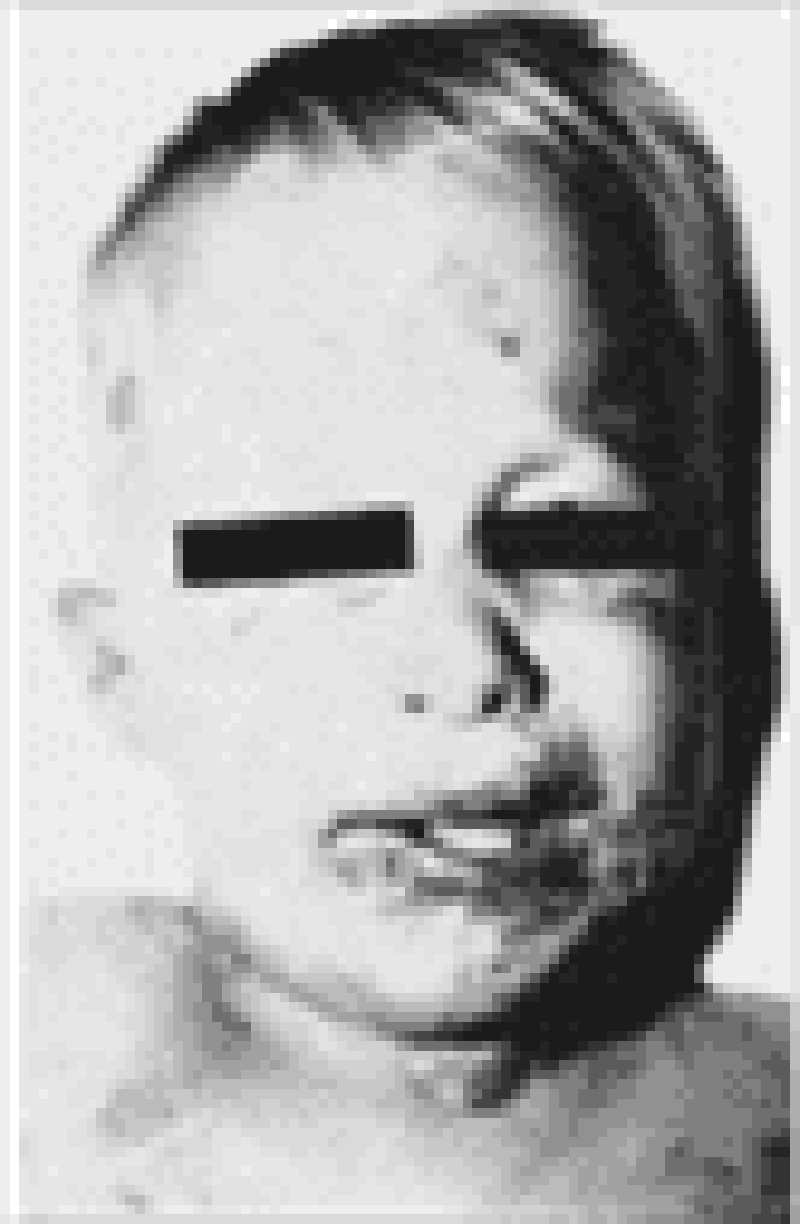
241) The rash and mucous membrane lesions shown in the photograph below develop in an infant 5 days into the course of an upper respiratory infection with otitis media; the child is being treated with amoxicillin. The child’s condition is likely which of the following?
A) Urticaria
B) Rubeola
C) Stevens-Johnson syndrome
D) Kawasakidisease
E) Scarlet fever
242) An 8-year-old immigrant from rural Central America presents with complaints of weakness, facial swelling, muscle pain, and fever. A CBC reveals marked eosinophilia. Which of the following parasites is most likely to be responsible?
A) Cryptosporidium parvum
B) Sporothrix schenckii
C) Giardia lambila
D) Enterobius vermicularis
E) Trichinella spiralis
243) A patient presents to the emergency center with a 6-hour history of fever to 38.9C (102F). Her mother reports that the patient appeared to be feeling poorly, that she had been eating less than normal, and that she vomited once. About 2 hours prior to arrival at the ER, the mother states that she noted a few purple spots scattered about the body on the patient, especially on the buttocks and legs. On the 30-minute ride to the ER, the purple areas spread rapidly and became coalesced in areas, and the patient is now obtunded. Which of the following is the most likely diagnosis?
A) Henoch-Schönlein purpura
B) Toxicshock syndrome caused by S aureus
C) Measles
D) Rocky Mountain spotted fever
E) Meningococcemia
244) A 2-month-old infant comes to the emergency center with fever for 2 days, emesis, a petechial rash, and increasing lethargy. In the ambulance he had a 3-minute generalized tonic/clonic seizure that was aborted with lorazepam. He does not respond when blood is drawn or when an IV is placed, but he continues to ooze blood from the skin puncture sites. On examination, his anterior fontanelle is open and bulging. His CBC shows a WBC of 30,000 cells/L with 20% band forms. Which of the infant’s problems listed below is a contraindication to lumbar puncture?
A) Uncorrected bleeding diathesis
B) Bulging fontanelle
C) Dehydration
D) History of recent seizure
E) Significantly elevated WBC count consistent with bacteremia
245) The mother of one of your regular patients calls your office. She reports that her daughter has a 3-day history of subjective fever, hoarseness, and a bad barking cough. You arrange for her to be seen in your office that morning. Upon seeing this child, you would expect to find which of the following?
A) A temperature greater than 38.9C (102F)
B) Expiratorystridor
C) Infection with parainfluenza virus
D) Hyperinflation on chest x-ray
E) A child between 6 and 8 years of age
246) Two weeks after a viral syndrome, a 2-year-old child develops bruising and generalized petechiae, more prominent over the legs. No hepatosplenomegaly or lymph node enlargement is noted. The examination is otherwise unremarkable. Laboratory testing shows the patient to have a normal hemoglobin, hematocrit, and white blood cell (WBC) count and differential. The plateletcount is 15,000/L. Which of the followingis the most likely diagnosis?
A) Von Willebrand disease (vWD)
B) Acute leukemia
C) Idiopathic (immune) thrombocytopenic purpura (ITP)
D) Aplastic anemia
E) Thrombotic thrombocytopenicpurpura
247) An 11-month-old African American boy has a hematocrit of 24% on a screening laboratory done at his well-child checkup. Further testing demonstrates: hemoglobin 7.8 g/dL; hematocrit 22.9%; leukocyte count 12,200/L with 39% neutrophils, 6% bands, 55% lymphocytes; hypochromia on smear; free erythrocyte protoporphyrin (FEP) 114 g/dL; lead level 6 g/dL whole blood; platelet count 175,000/L; reticulocyte count 0.2%; sickle-cell preparation negative; stool guaiac-negative; and mean corpuscular volume (MCV) 64 fL. Which of the following is the most appropriate recommendation?
A) Blood transfusion
B) Oralferrous sulfate
C) Intramuscular iron dextran
D) An iron-fortified cereal
E) CalciumEDTA
248) The parents of a previously healthy 2-year-old child note her to be pale and bring her to your clinic for evaluation. She currently has no fever, nausea, emesis, bone pain, or other complaints. Her examination is significant for pallor, tachycardia, and a systolic ejection murmur, but she has no organomegaly. Her complete blood count (CBC) reveals a hemoglobin of 4 g/dL, normal indices for age, a WBC count of 6.5/L, and a platelet count of 750,000/L. Her reticulocyte count is 0%. Coombs test is negative. Her peripheral blood smear shows no blast forms and no fragments. Red blood cell (RBC) adenosine deaminase levels are normal. A bone marrow reveals markedly decreased erythroid precursors. Which of the following is this child’s likely diagnosis?
A) Diamond-Blackfan anemia
B) Sickle-cell anemia
C) Pearson marrow-pancreas syndrome
D) Iron deficiency anemia
E) Transient erythroblastopenia of childhood
249) On a routine-screening CBC, a 1-year-old is noted to have a microcytic anemia. A follow-up hemoglobin electrophoresis demonstrates an increased concentration of hemoglobin A2. The child is most likely to have which of the following?
A) Iron deficiency
β) B-Thalassemia trait
C) Sickle-cell anemia
D) Chronic systemic illness
E) Lead poisoning
250) After being delivered following a benign gestation, a newborn infant is noted to have a platelet count of 35,000/L, decreased fibrinogen, and elevated fibrin spilt products. On examination you note a large cutaneous hemangioma on the abdomen that is purple and firm. Which of the following anomalies might also be expected in this infant?
A) Kaposiform hemangio endothelioma
B) Nevus simplex
C) Nevus flammeus
D) PHACE(S) syndrome
E) Infantile fibrosarcoma
251) A 4-year-old previously well African American boy is brought to the office by his aunt. She reports that he developed pallor, dark urine, and jaundice over the past few days. He stays with her, has not traveled, and has not been exposed to a jaundiced person, but he is taking trimethoprim sulfamethoxazole for otitis media. The CBC in the office shows a low hemoglobin and hematocrit, while his “stat” serum electrolytes, blood urea nitrogen (BUN), and chemistries are remarkable only for an elevation of his bilirubin levels. His aunt seems to recall his 8-year-old brother having had an “allergic reaction” to aspirin, which also caused a short-lived period of anemia and jaundice. Which of the following is the most likely cause of this patient’s symptoms?
A) Hepatitis B
B) Hepatitis A
C) Hemolytic-uremic syndrome
D) Gilbert syndrome
E) Glucose-6-phosphate dehydrogenase deficiency
252) Your sister who lives in another state sends via e-mail photographs of her 6-month- old infant. You note the child has a white reflection from one of his eyes. You hastily assist in arranging an urgent pediatric ophthalmologic evaluation. Your sister immediately accesses the Internet and begins to ask questions of you. Which of the following statements found by your sister is correct?
A) Most cases of retinoblastoma are unilateral and hereditary.
B) Cure rates for retinoblastoma treated in the United States exceed 90%.
C) Biopsy is usually performed to confirm the diagnosis.
D) Intraocular calcifications are an unusual finding and suggest worse prognosis.
E) Patients with the hereditary form of retinoblastoma are at significantly increased risk of leukemia in later years.
253) A 2950-g (6.5-lb) black baby boy is born at home at term. On arrival at the hospital, he appears pale, but the physical examination is otherwise normal. Laboratory studies reveal the following: mother’s blood type A, Rh-positive; baby’s blood type O, Rh-positive; hematocrit 38%; and reticulocyte count 5%. Which of the following is the most likely cause of the anemia?
A) Fetomaternal transfusion
B) ABO incompatibility
C) Physiologic anemia of the newborn
D) Sickle-cell anemia
E) Iron-deficiency anemia
254) A father brings his 3-year-old daughter to the emergency center after noting her to be pale and tired and with a subjective fever for severaldays. Her past history is significant for an upper respiratory infection 4 weeks prior, but she had been otherwise healthy. The father denies emesis or diarrhea, but does report his daughter has had leg pain over the previous week, waking her from sleep. He also reports that she has been bleeding from her gums after brushing her teeth. Examination reveals a listless pale child. She has diffuse lymphadenopathy with splenomegaly but no hepatomegaly. She has a few petechiae scattered across her face and abdomen and is mildly tender over her shins, but does not have associated erythema or joint swelling. A CBC reveals a leukocyte count of 8,000/L with a hemoglobin of 4 g/dL and a platelet count of 7,000/L. The automated differential reports an elevated number of atypical lymphocytes. Which of the following diagnostic studies is the most appropriate next step in the management of this child?
A) Epstein-Barr virus titers
B) Serum haptoglobin
C) Antiplatelet antibody assay
D) Reticulocyte count
E) Bone marrow biopsy
255) While bathing her newly-received 2-year-old son, a foster mother feels a mass in his abdomen. A thorough medical evaluation of the child reveals aniridia, hypospadias, horseshoe kidney, and hemihypertrophy. Which of the following is the most likely diagnosis for this child?
A) Neuroblastoma
B) Wilms tumor
C) Hepatoblastoma
D) Rhabdomyosarcoma
E) Testicular cancer
256) A healthy 1-year-old child comes to your office for a routine checkup and for immunizations. His parents have no complaints or concerns. The next day, the CBC you performed as customary screening for anemia returns with the percentage of eosinophils on the differential to be 30%. Which of the following is the most likely explanation?
A) Bacterial infections
B) Chronic allergic rhinitis
C) Fungal infections
D) Helminth infestation
E) Tuberculosis
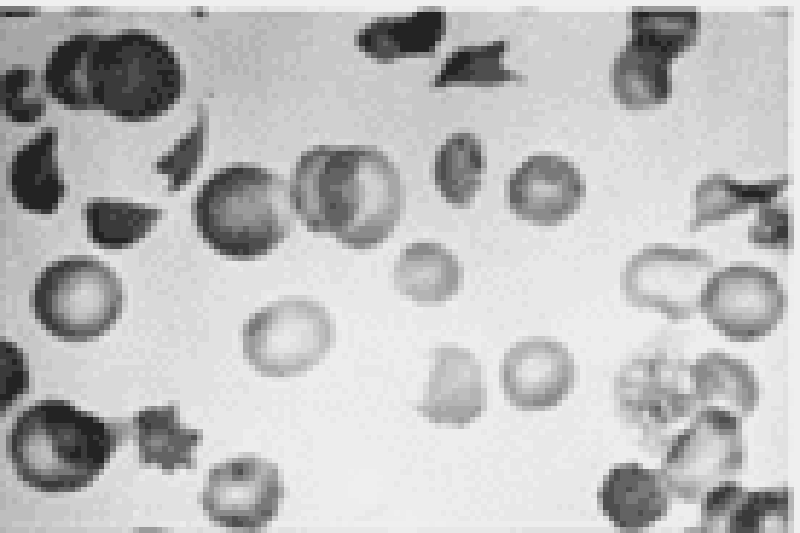
257) A 2-year-old child in shock has multiple nonblanching purple lesions of various sizes scattered about on the trunk and extremities; petechiae are noted, and oozing from the venipuncture site has been observed. The child’s peripheral blood smear is shown below. Clotting studies are likely to show which of the following?
A) Increased levels of factor V and VIII
B) A decreased prothrombin level
C) An increased fibrinogen level
D) The presence of fibrin split products
E) Normal partial thromboplastin time (PTT)
258) A male infant was found to be jaundiced 12 hours after birth. At 36 hours of age, his serum bilirubin was 18 mg/dL, hemoglobin concentration was 12.5 g/dL, and reticulocyte count 9%. Many nucleated RBCs and some spherocytes were seen in the peripheral blood smear. The differential diagnosis should include which of the following?
A) Pyruvate kinase deficiency
B) Hereditary spherocytosis
C) Sickle-cell anemia
D) Rh incompatibility
E) Polycythemia
259) On a routine well-child examination, a 1-year-old boy is noted to be pale. He is in the 75th percentile for weight and the 25th percentile for length. Results of physical examination are otherwise normal. His hematocrit is 24%. The answer to which of the following questions is most likely to be helpful in making a diagnosis?
A) What is the child’s usual daily diet?
B) Did the child receive phototherapy for neonatal jaundice?
C) Has anyone in the family received a blood transfusion?
D) Is the child on any medications?
E) What is the pattern and appearance of his bowel movements?
260) A 10-year-old boy is admitted to the hospital because of bleeding. Pertinent laboratory findings include a platelet count of 50,000/L, prothrombin time (PT) of 15 seconds (control 11.5 seconds), activated partial thromboplastin time (aPTT) of 51 seconds (control 36 seconds), thrombin time (TT) of 13.7 seconds (control 10.5 seconds), and factor VIII level of 14% (normal 38%-178%). Which of the following is the most likely cause of his bleeding?
A) Immune thrombocytopenic purpura (ITP)
B) Vitamin K deficiency
C) Disseminated intravascular coagulation (DIC)
D) Hemophilia A
E) Hemophilia B
261) A 17-year-old adolescent comes to your office seeking help for “heavy” menses. Your review of systems also reveals weekly epistaxis. Her only significant past history includes a tonsillectomy at age 6 after which she required blood transfusion for excessive bleeding. Her family history includes several people who seem to bleed and bruise more easily than others. The patient’s mother required a hysterectomy after child birth for excessive hemorrhage. You order a variety of laboratory tests. The patient has a hemoglobin of 6.5 mg/dL with an MCV of 60%; her platelet count is 350,000/L. Her von Willebrand antigen and her von Willebrand factor (vWF) activity (ristocetin cofactor activity) are decreased. Her vWF is reported as normal but in decreased amounts. You have been unable to reach her to report the findings, but when she calls about 1 week later she reports she is having a mild to moderate nosebleed. You initiate therapy with which of the following?
A) Aminocaproic acid (Amicar)
B) vWF concentrate alone
C) vWF with factor VIII
D) Desmopressin (DDAVP)
E) Intravenous immunoglobulin (IVIG)
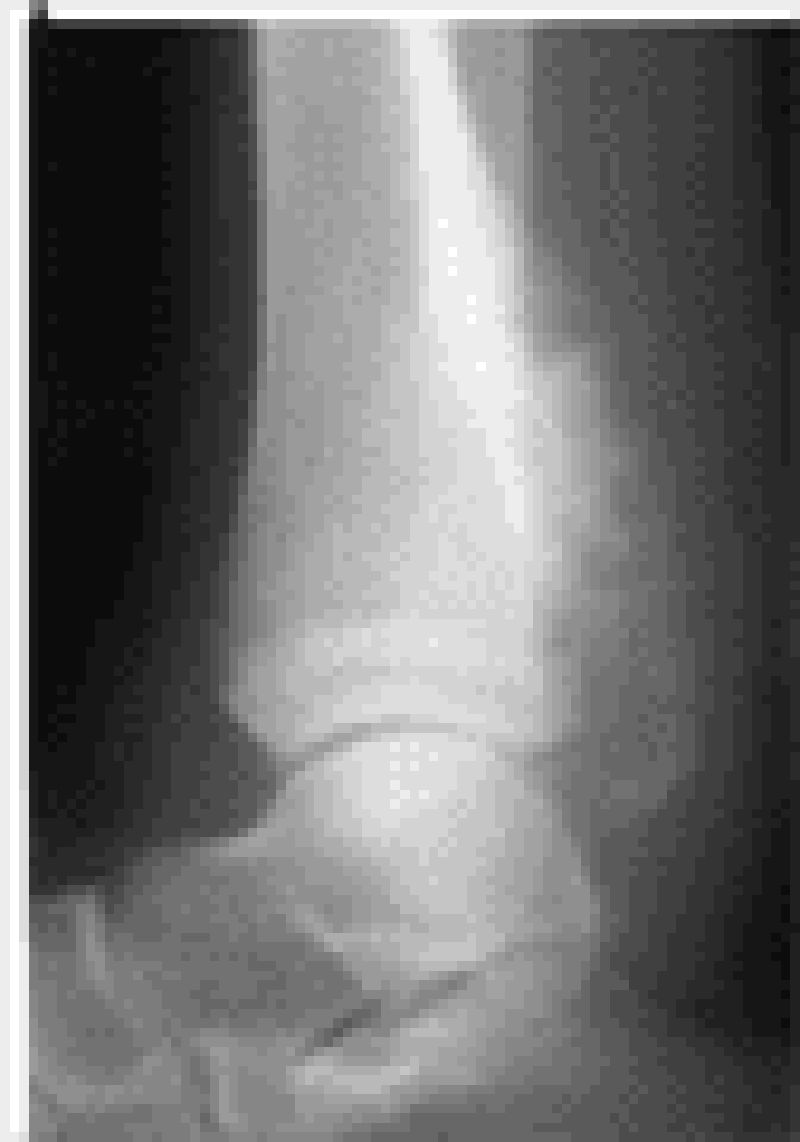
262) Over the previous 2 to 3 weeks, a very active 13-year-old white boy is noted by his family to have developed deep pains in his leg that awaken him from sleep. The family brings him to your office with a complaint of a swelling over his distal leg, which he attributes to his being kicked while playing soccer about 1 week ago. He has had no fever, headaches, weakness, bruising, or other symptoms. A radiograph of the leg is shown below. Which of the following is the most likely explanation for his pain?
A) Growingpains
B) Leukemia
C) Osteomyelitis
D) Bone fracture
E) Osteosarcoma
263) An otherwise healthy 17-year-old complains of swollen glands in his neck and groin for the past 6 months and an increasing cough over the previous 2 weeks. He also reports some fevers, especially at night, and possibly some weight loss. On examination, you notice that he has nontender cervical, supraclavicular, axillary, and inguinal nodes, no hepatosplenomegaly, and otherwise looks to be fairly healthy. Which of the following would be the appropriate next step?
A) Biopsy of a node
B) CBC and differential
C) Trial of antituberculosis drugs
D) Chest radiograph
E) Cat-scratchtiters
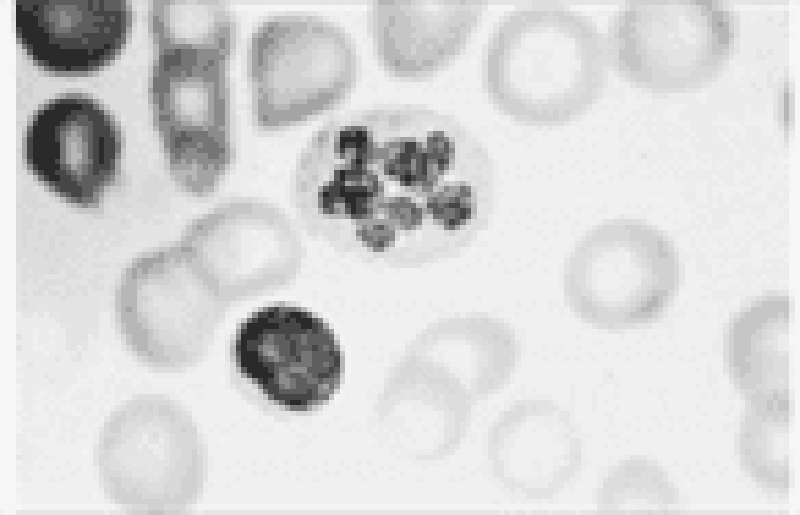
264) An otherwise healthy child has on his 1-year-old routine CBC the polymorphonuclear neutrophil shown below. This child likely has which of the following?
A) Malignancy
B) Iron deficiency
C) Folic acid deficiency
D) Döhleinclusion bodies
E) The Pelger-Huët nuclear anomaly
265) A 6-month-old infant has been exclusively fed a commercially available infant formula. Upon introduction of fruit juices, however, the child develops jaundice, hepatomegaly, vomiting, lethargy, irritability, and seizures. Tests for urine-reducing substances are positive. Which of the following is likely to explain this child’s condition?
A) Tyrosinemia
B) Galactosemia
C) Hereditary fructose intolerance
D) 1-Antitrypsin deficiency
E) Glucose-6-phosphatase deficiency
266) An infant is born to a woman who has received very little prenatal care. The mother is anxious, complains of heat intolerance and fatigue, and reports that she has not gained much weight despite having an increased appetite. On examination the mother is tachycardic, has a tremor, and has fullness in her neck and in her eyes. The infant is most likely at risk for development of which of the following?
A) Constipation
B) Heart failure
C) Macrocephaly
D) Third-degree heart block
E) Thrombocytosis
267) An otherwise healthy 7-year-old girl is brought to your office by her father because she has some acne, breast development, and fine pubic hair. Which of the following is the most likely etiology for her condition?
A) A feminizing ovarian tumor
B) A gonadotropin-producing tumor
C) A lesion of the central nervous system (CNS)
D) Exogenous estrogens
E) Early onset of “normal” puberty (constitutional)
268) The parents of a 14-year-old boy are concerned about his short stature and lack of sexual development. By history, you learn that his birth weight and length were 3 kg and 50 cm, respectively, and that he had a normal growth pattern, although he was always shorter than children his age. The physical examination is normal and his growth curve is shown on the next page. His upper-to-lower segment ratio is 0.98. A small amount of fine axillary and pubic hair is present. There is no scrotalpigmentation; his testes measure 4.0 cm3 and his penis is 6 cm in length. In this situation, which of the following is the most appropriate course of action?
A) Measure pituitary gonadotropin
B) Obtain a computed tomographic (CT) scan of the pituitary area
C) Biopsy his testes
D) Measure serum testosterone levels
E) Reassure the parents that the boy is normal
269) Friends are considering adopting a “special needs” child from another country. The family has few details, but the information they have received so far suggests the 4-year-old child has had surgery for an endocardial cushion defect, is short for his age, and had a history of what sounds like surgically repaired duodenal atresia at birth. You are suspicious this child may have which of the following syndromes?
A) Kleinfelter
B) Waardenberg
C) Marfan
D) Down
E) Turner
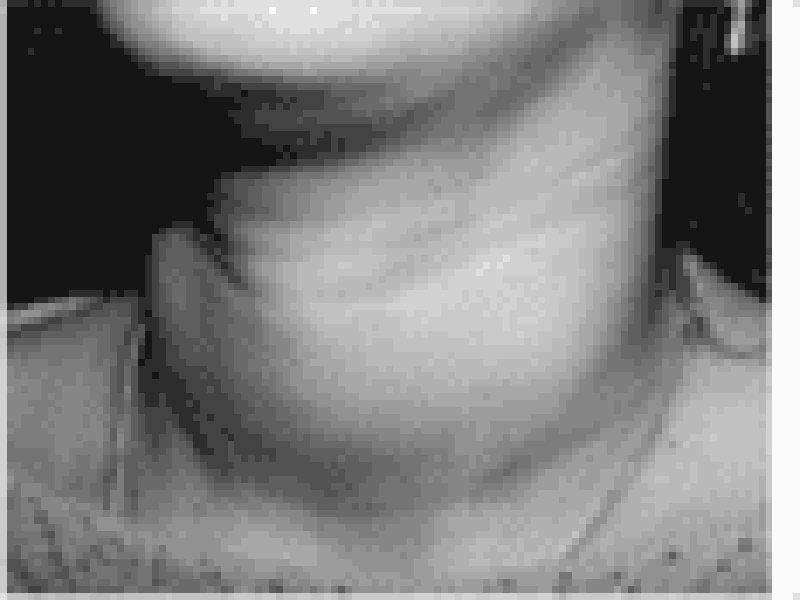
270) A 13-year-old asymptomatic girl is shown below. She states that the findings demonstrated began more than a year ago. Which of the following is the most likely diagnosis?
A) Iodine deficiency
B) Congenital hypothyroidism
C) Graves’ disease
D) Exogenous ingestion of Synthroid
E) Lymphocytic (Hashimoto) thyroiditis
271) During a routine well-child examination a 10-year-old girl reports that she has occasional headache, “racing heart,” abdominal pain, and dizziness. Her mother states that she has witnessed one of the episodes, which occurred during an outing at the mall, and reported the child to be pale and to have sweating as well. Other than some hypertension, she has a normal physical examination. Evaluation of this child is most likely to result in which of the following diagnoses?
A) Hysterical fainting spells
B) Pregnancy
C) Diabetesmellitus
D) Pheochromocytoma
E) Migraine headache
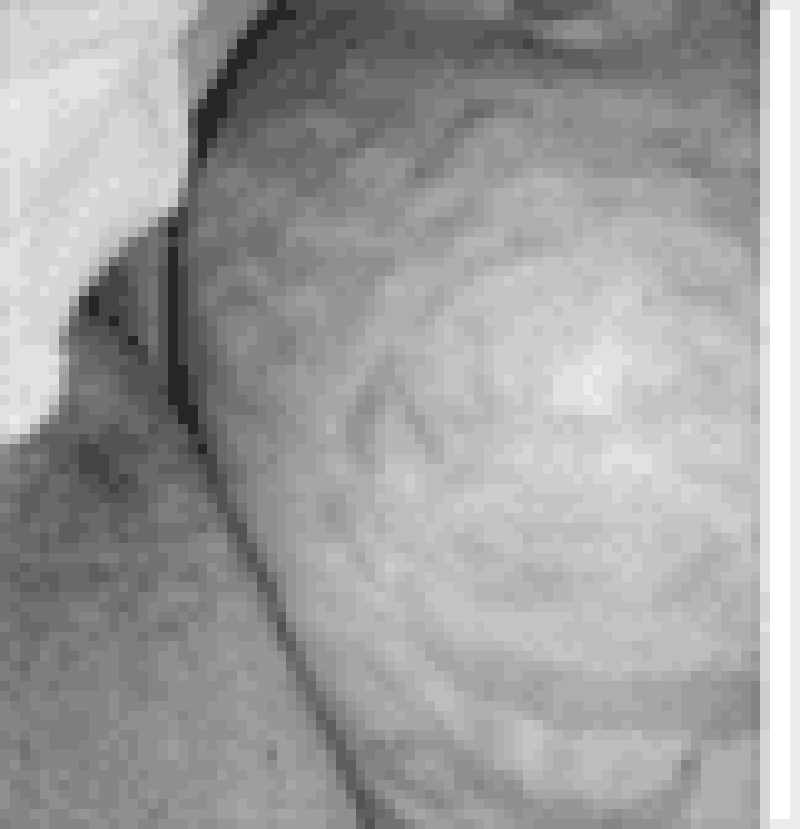
272) A 10-year-old obese child (shown below) has central fat distribution, arrested growth, hypertension, plethora, and osteoporosis. Which of the following disorders is most likely responsible for the clinical picture that this boy presents?
A) Bilateral adrenal hyperplasia
B) Adrenaladenoma
C) Adrenal carcinoma
D) Craniopharyngioma
E) Ectopic adrenocorticotropin-producing tumor
273) A 6-year-old boy is brought to your practice by his paternal grandmother for his first visit. She has recently received custody of him after his mother entered the penal system in another state; she does not have much information about him. You note that the child is short for his age, has downslanting palpebral fissures, ptosis, low-set and malformed ears, a broad and webbed neck, shield chest, and cryptorchidism. You hear a systolic ejection murmur in the pulmonic region. His grandmother reports that he does well in regular classes, but has been diagnosed with learning disabilities and receives speech therapy for language delay. His constellation of symptoms is suggestive of which of the following?
A) Noonan syndrome
B) Congenital hypothyroidism
C) Turner syndrome
D) Congenital rubella
E) Down syndrome
274) The parents of a 1-month-old infant bring him to the emergency center in your local hospital for emesis and listlessness. Both of his parents wanted a natural birth, so he was born at home and has not yet been to see a physician. On examination, you find a dehydrated, listless, and irritable infant. Although you don’t have a birth weight, the parents do not feel that he has gained much weight. He has significant jaundice. His abdominal examination is significant for both hepatomegaly and splenomegaly. Laboratory values include a total bilirubin of 15.8 mg/dL and a direct bilirubin of 5.5 mg/dL. His liver function tests are elevated and his serum glucose is 38 mg/dL. Serum ammonia is normal. A urinalysis is negative for glucose, but it has a “mouse-like” odor. These findings are consistent with which of the following conditions?
A) Homocystinuria
B) Maple syrup urine disease
C) Galactosemia
D) Ornithine transcarbamylase deficiency
E) Phenylketonuria
275) An otherwise healthy 7-year-old child is brought to you to be evaluated because he is the shortest child in his class. Carefulmeasurements of his upper and lower body segments demonstrate normal body proportions for his age. Which of the following disorders of growth should remain in your differential?
A) Achondroplasia
B) Morquio disease
C) Hypothyroidism
D) Growth hormone deficiency
E) Marfan syndrome
276) The state laboratory calls your office telling you that a newborn infant, now 8 days old, has an elevated thyroid stimulating hormone (TSH) and low thyroxin (T4) on his newborn screen. If this condition is left untreated, the infant is likely to demonstrate which of the following in the first few months of life?
A) Hyperreflexia
B) Hyperirritability
C) Diarrhea
D) Prolonged jaundice
E) Hyperphagia
277) A 1-year-old boy presents with the complaint from his parents of “not developing normally.” He was the product of an uneventful term pregnancy and delivery, and reportedly was normal at birth. His previous health-care provider noted his developmental delay, and also noted that the child seemed to have an enlarged spleen and liver. On your examination, you confirm the developmental delay and the hepatosplenomegaly, and also notice that the child has short stature, macrocephaly, hirsutism, a coarse facies, and decreased joint mobility. Which of the following is the most likely etiology of his condition?
A) Beckwith-Wiedemann syndrome
B) Crouzon syndrome
C) Trisomy 18 (Edwards syndrome)
D) Jeune syndrome
E) Hurler syndrome
278) A 13-year-old comes to your office expressing concern about his height. He had first seen you a year prior for his routine checkup and a preparticipation sports physical for soccer (see growth curve). Now in the eighth grade, all of his friends are taller than he is, and he is at a disadvantage on the soccer field playing against much larger boys. After obtaining height information from his parents shown here, you order a skeletal bone age radiograph. Which of the following results would allow you to assure him of an excellent prognosis for normal adult height?
A) A bone age of 9 years
B) A bone age of 13 years
C) A bone age of 15 years
D) Being at the 50th percentile for weight
E) Being at the 3rd percentile for weight
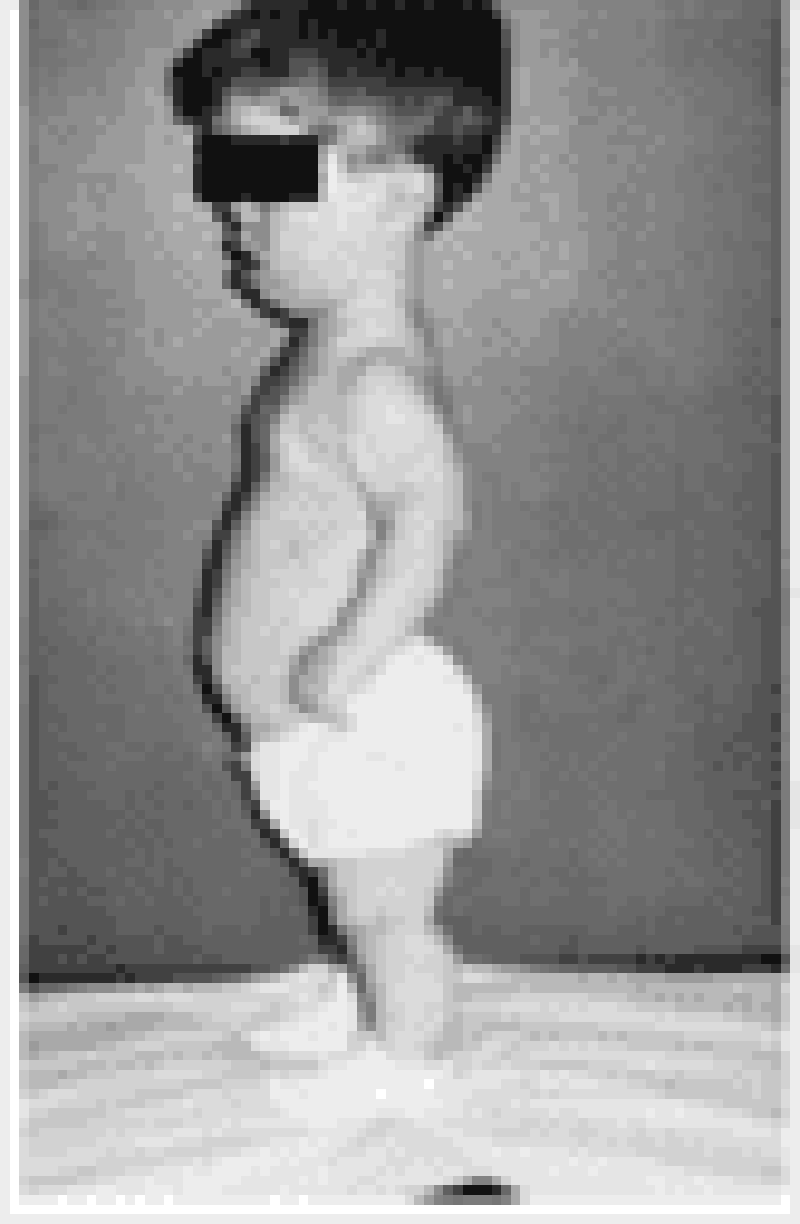
279) The parents of the child pictured below bring him to the office for evaluation of short stature. At 5 years of age, he is the shortest child in his kindergarten class. His development is normal, and he is reading on a first grade level. Both parents are of normal height, and this child resembles no one in the family. Which of the following is the most likely diagnosis?
A) Achondrogenesis
B) Achondroplasia
C) Metatropic dysplasia
D) Thanatophoric dwarfism
E) Chondroectodermal dysplasia
280) A 12-year-old girl has a solitary thyroid nodule found on routine examination; she has no symptoms. Which of the following is the most appropriate next step for this patient?
A) Fine needle aspirate
B) CT scan of the neck
C) Serum thyroid function tests
D) Trial of suppressive T4 treatment to look for nodule shrinkage
E) Excisionalbiopsy
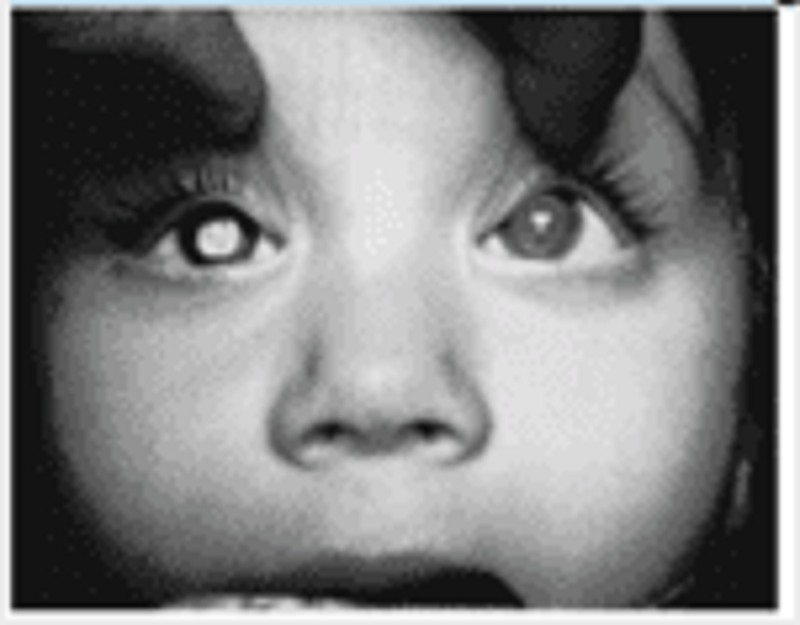
281) The 16-month-old male infant pictured below was recently brought from a developing country to the United States. The family history reveals that his father had an eye and a leg removed. Which of the following is the most likely diagnosis?
A) Coloboma of the choroid
B) Retinaldetachment
C) Nematode endophthalmitis
D) Retinoblastoma
E) Persistent hyperplastic primary vitreous
282) A 4-year-old child has mental retardation, shortness of stature, brachydactyly (especially of the fourth and fifth digits), and obesity with round facies and short neck. The child is followed by an ophthalmologist for subcapsular cataracts, and has previously been noted to have cutaneous and subcutaneous calcifications, as well as perivascular calcifications of the basal ganglia. This patient is most likely to have which of the following features?
A) Hypercalcemia
B) Hypophosphatemia
C) Elevated concentrations of parathyroid hormone
D) Advanced height age
E) Decreased bone density, particularly in the skull
283) A 15-year-old boy has been immobilized in a double hip spica cast for 6 weeks after having fractured his femur in a skiing accident. He has become depressed and listless during the past few days and has complained of nausea and constipation. He is found to have microscopic hematuria and a blood pressure of 150/100 mm Hg. Which of the following is the most appropriate course of action?
A) Request a psychiatric evaluation
B) Check blood pressure every 2 hours for 2 days
C) Collect urine for measurement of the calcium to creatinine ratio
D) Order a renal sonogram and intravenous pyelogram (IVP)
E) Measure 24-hour urinary protein
284) An adolescent with type 1 diabetes returns for a follow-up visit after his annual checkup last week. You note that his serum glucose is elevated, and his glycosylated hemoglobin (hemoglobin A1C) is 16.7%. This finding suggests poor control of his diabetes over at least which of the following time periods?
A) 8 hours
B) 1 week
C) 1 month
D) 2 months
E) 6 months
285) A 7-day-old boy is admitted to a hospital for evaluation of vomiting and dehydration. Physical examination is otherwise normal except for minimal hyperpigmentation of the nipples. Serum sodium and potassium concentrations are 120 mEq/L and 9 mEq/L (without hemolysis), respectively; serum glucose is 40 mg/dL. Which of the following is the most likely diagnosis?
A) Pyloric stenosis
B) Congenital adrenal hyperplasia
C) Secondary hypothyroidism
D) Panhypopituitarism
E) Hyperaldosteronism
286) A 14-year-old boy presents with the complaint of “breast swelling.” The boy reports that he has been in good health and without other problems, but has noticed over the past month or so that his left breast has been “achy” and that he has now noticed some mild swelling under the nipple. He has never seen discharge; the other breast has not been swelling; and he denies trauma. Your examination demonstrates a quarter-sized area of breast tissue under the left nipple that is not tender and has no discharge. The right breast has no such tissue. He has a normal genitourinary examination, and is Tanner stage 3. Which of the following is the best next course of action?
A) CT scan of the pituitary
B) Measurement of serum luteinizing hormone (LH) and follicle-stimulating hormone (FSH)
C) Measurement of serum testosterone
D) Reassurance of the normalcy of the condition
E) Chromosomes
287) An infant is brought to a hospital because her wet diapers turn black when they are exposed to air. Physical examination is normal. Urine is positive both for reducing substance and when tested with ferric chloride. This disorder is caused by a deficiency of which of the following?
A) Homogentisic acid oxidase
B) Phenylalanine hydroxylase
C) L-histidineammonia-lyase
D) Ketoacid decarboxylase
E) Isovaleryl-CoA dehydrogenase
288) An 18-year-old girl has hepatosplenomegaly, an intention tremor, dysarthria, dystonia, and deterioration in her school performance. She also developed abnormal urine with excess glucose, protein, and uric acid. She has a several-year history of elevated liver enzymes of unknown etiology. Which of the following best explains her condition?
A) Indian childhood cirrhosis
B) Alpha1-Antitrypsin deficiency
C) Menkes syndrome
D) Dubin-Johnson syndrome
E) Wilson disease
289) A 3-month-old infant without significant past history was brought to the emergency center by her mother with a generalized tonic-clonic seizure. She is found to have glucose of 5 mg/dL. After correction of her hypoglycemia, she is admitted to your service for further evaluation. Several hours later, her nurse calls to tell you that her bedside glucose check was now 10 mg/dL. You order laboratory work suggested by the pediatric endocrinology team and again correct the infant’s hypoglycemia. The results of the laboratory tests you drew include an elevated serum insulin level of 50 U/mL, and a low IGFBP-1 (plasma insulin-like growth factor binding protein-1). C-peptide levels are not detectable. Which of the following is the likely cause of this child’s recurrent hypoglycemia?
A) Nesidioblastosis
B) Pancreatitis
C) Beckwith-Wiedemann syndrome
D) Galactosemia
E) Factitious hypoglycemia

290) A very upset mother brings her 8-month-old child to the emergency room because he will not move his leg. She reports that when she was carrying him to the car about half an hour ago, she slipped on some ice and fell on top of him. The mother, an 18-year-old African American woman, has been exclusively breast-feeding her child. She has only recently started him on cereals, and has not supplemented his diet with vitamins. A radiograph of the child’s leg is shown below. Which of the following laboratory findings would be expected?
A) Hypocalcemia
B) Hypophosphaturia
C) Reduced serum alkaline phosphatase
D) Hypocalciuria
E) Hyperphosphatemia
291) A small-for-gestational-age infant is born at 30 weeks’ gestation. At 1 hour of age, his serum glucose is noted to be 20 mg/dL (normally greater than 40 mg/dL). Which of the following is the most likely explanation for hypoglycemia in this infant?
A) Inadequate stores of nutrients
B) Adrenal immaturity
C) Pituitary immaturity
D) Insulin excess
E) Glucagondeficiency
292) A 1-day-old normal-appearing infant develops tetany and convulsions. He was born at 34 weeks’ gestation with Apgar scores of 2 and 4 (at 1 and 5 minutes, respectively) to a woman whose pregnancy was complicated by diabetes mellitus and pregnancy-induced hypertension. Which of the following serum chemistry values is likely to be the explanation for his condition?
A) Serum bicarbonate level of 22 mEq/dL
B) Serum calcium of 6.2 mg/dL
C) Serum glucose of 45 mg/dL
D) Serum magnesium level of 5.0 mg/dL
E) Intracranial hemorrhage
293) A 15-year-old female presents to your office with secondary amenorrhea. As part of your evaluation, you find that she is pregnant. After informing her of the pregnancy, you continue to explain that young mothers have a higher risk of several pregnancy-related complications, including which of the following?
A) Twin gestation
B) Low-birth weight infants
C) Hypotension
D) Excessive weight gain
E) Infants with genetic defects
294) A 16-year-old boy who is the backup quarterback for the local high school team is in your office complaining of worsening acne. For the last few months he has noted more acne and more oily hair. On his examination, you note gynecomastia and small testicular volume. He is SMR 5. Which of the following drugs of abuse is the likely explanation for all of his findings?
A) Cocaine
B) Oxandrolone
C) Marijuana
D) Toluene
E) Methylenedioxymethamphetamine
295) A 15-year-old girl is brought to the pediatric emergency room by the lunchroom teacher, who observed her sitting alone and crying. On questioning, the teacher learned that the girl had taken five unidentified tablets after having had an argument with her mother about a boyfriend of whom the mother disapproved. Toxicology studies are negative, and physical examination is normal. Which of the following is the most appropriate course of action?
A) Hospitalize the teenager on the adolescent ward.
B) Get a psychiatry consultation.
C) Get a social service consultation.
D) Arrange a family conference that includes the boyfriend.
E) Prescribe an antidepressant and arrange for a prompt clinic appointment.
296) A 15-year-old girl is seen in your clinic with a sprained ankle, which occurred the previous day while she was exercising in her room. You realize that you have not seen her for quite some time, and begin to expand your examination beyond the ankle. You find relatively minimal swelling on her right ankle. She has dental decay, especially of anterior teeth and a swollen, reddened, irritated uvula. She seems to be somewhat hirsute on her arms and legs, but has thinning of her hair of the head. She has a resting heart rate of 60 beats per minute, and her oral temperature is 35.5°C (96F). Further questioning suggests that she has developed secondary amenorrhea. Which of the following is the most appropriate next step in the management of this girl?
A) Human immunodeficiency virus (HIV) testing
B) Radiograph of ankle
C) Thyroid function panel
D) Comparison of current and past weights
E) Pregnancy testing
297) A 17-year-old sexually active girl comes to your office complaining of acne that is unresponsive to the usual treatment regimen. Physical examination reveals severe nodulocystic acne of her face, upper chest, and back. You consider prescribing isotretinoin (Accutane), but you are concerned about side effects. Reviewing the literature, you find which of the following to be true about isotretinoin?
A) Its efficacy can be profound and permanent.
B) It is not known to be a teratogen.
C) Most patients experience excessive tearing and salivation.
D) Severe arthritis necessitating cessation of the drug occurs in about 15% of patients.
E) Significant decrease in serum triglyceride levels are noted in 25% of patients.
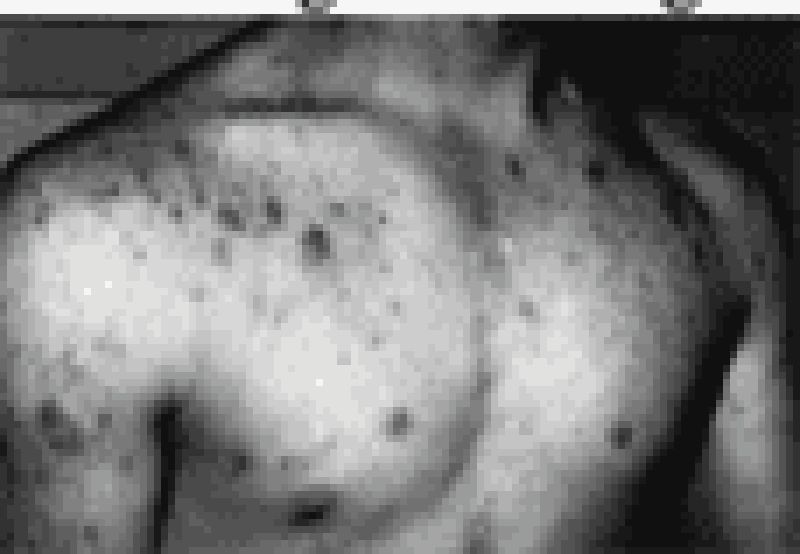
298) A 15-year-old presents with the complaint of a rash, as pictured below. Which of the following statements is correct concerning the management of this common condition?
A) Fried foods must be avoided.
B) Frequent scrubbing of the affected areas is key.
C) Topical antibiotics are of no value.
D) Topical benzoyl peroxide is the mainstay of treatment.
E) This rash is solely a disease of the adolescent.
299) A 15-year-old athlete is in your office for his annual physical examination before the start of football season. He has no complaints, has suffered no injuries, and appears to be physically fit. On his heart examination, you note a heart rate of 100 beats per minute, and a diffuse point of maximal impulse (PMI) with a prominent ventricular lift. He has a normal S1 and S2, with an S4 gallop. He has no murmur sitting, but when he stands you clearly hear a systolic ejection murmur along the lower left sternal edge and the apex. For which of the following conditions is this examination most consistent?
A) Wolff-Parkinson-White syndrome
B) Valvular aortic stenosis
C) Valvular pulmonic stenosis
D) Myocarditis
E) Hypertrophic cardiomyopathy
300) A 16-year-old girl, accompanied by her mother, is in your office for a well-adolescent visit. The mother asks about drug and alcohol abuse. You explain that the warning signs of abuse include which of the following?
A) Excessive concern for weight and body configuration
B) Improved school performance
C) Recent changes from age-appropriate, acceptable friends to younger associates
D) Deterioration in personal habits, hygiene, dress, grooming, speech patterns, and fluency of expression
E) Improvement in relationships with adults, siblings, and authority figures
301) The recent suicide of a well-known high school cheerleader in your community has generated an enormous amount of community concern and media coverage. A girl who was close friends with the deceased makes an appointment and comes in to your office to discuss the event with you. You ask, and she denies suicidal ideation, but she has many questions about suicide. Correct statements about adolescent suicide include which of the following?
A) Girls tend to use more lethal means.
B) The number of attempted suicides is much higher among boys.
C) Those who are successfulhave a history of a prior attempt or prior serious suicidal ideation.
D) Inquiry by pediatricians, high school teachers, parents, or friends about suicidal thoughts typically precipitates the act.
E) The number of suicides in adolescents 10 to 19 years of age has decreased significantly since the 1950s.
302) A 16-year-old girl is in your office for a preparticipation sports examination. She plans to play soccer in the fall, and needs her form filled out. Which of the following history or physical examination findings is usually considered a contraindication to playing contact sports?
A) Congenital heart disease, repaired
B) Obesity
C) Absence of a single ovary
D) Absence of a single eye
Diabetes mellitus
303) A 15-year-old boy is in the office for a preparticipation sports physical examination before he begins playing with the varsity football team at his school. Although he is a skilled receiver, he will be one of the smallest players on the field and is concerned about the potential for injury. He asks how to bulk up. Appropriate advice to increase muscle mass includes which of the following?
A) Taking extra vitamins
B) Doubling protein intake
C) Using anabolic steroids
D) Increasing muscle work
E) Taking ergogenic medication
304) An 18-year-old male college student is seen in the student health clinic for urinary frequency, dysuria, and urethral discharge. Which of the following is likely to explain his condition?
A) Herpes simplex
B) Escherichia coli urinary tract infection
C) Chlamydial urethritis
D) Syphilis
E) HIV infection
305) A 19-year-old male college student returns from spring break in Fort Lauderdale, Florida, with complaints of acute pain and swelling of the scrotum. Physical examination reveals an exquisitely tender, swollen right testis that is rather hard to examine. The cremasteric reflex is absent, but there is no swelling in the inguinal area. The rest of his genitourinary examination appears to be normal. A urine dip is negative for red and white blood cells. Which of the following is the appropriate next step in management?
A) Administration of antibiotics after culture of urethra for Chlamydia and gonorrhea
B) Reassurance
C) Intravenous fluid administration, pain medications, and straining of all voids
D) Ultrasound of the scrotum
E) Laparoscopic exploration of both inguinal regions
306) A 16-year-old girl presents with lower abdominal pain and fever. On physical examination, a tender adnexal mass is felt. Further questioning in private reveals the following: she has a new sexual partner; her periods are irregular; she has a vaginal discharge. Which of the following is the most likely diagnosis?
A) Appendiceal abscess
B) Tubo-ovarian abscess
C) Ovarian cyst
D) Renal cyst
E) Ectopic pregnancy
307) The parents of a 16-year-old girl complain that she does not get enough sleep. They recently discovered that she stays awake most nights until 1:00 AM reading and text messaging her friends. She wakes at 6:30 AM for school, and complains of sleepiness during the day. On weekends she sleeps until noon. Her parents have tried taking away her computer and phone, but she still would go to bed at the same time. The parents are looking for advice in dealing with their “night owl” daughter. Which of the following is appropriate advice for this family?
A) Teens need less sleep than adults.
B) Effects of puberty on melatonin cause a phase delay with later sleep onset.
C) Most teens get an adequate number of hours of sleep each night.
D) Daytime sleepiness is a clear manifestation of an inadequate number of hours of sleep.
E) Sleeping in on weekends should repay the “sleep debt.”
308) A 15-year-old girl is admitted to the hospital with a 6-kg weight loss, bloody diarrhea, and fever that have occurred intermittently over the previous 6 months. She reports cramping abdominal pain with bowel movements. She also reports secondary amenorrhea during this time. Stool cultures in her physician’s office have shown only normal intestinal flora. A urine pregnancy test was negative, while an erythrocyte sedimentation rate (ESR) was elevated. Her examination is significant for the lack of oral mucosal ulcerations and a normal perianal examination. Anti-Saccharomyces cerevisiae antibodies (ASCA) are negative, while anti-neutrophil cytoplasm antibodies (p-ANCA) are positive. You confirm your presumptive diagnosis with a rectalbiopsy. In counseling her about her disease, which of the following statements would be true?
A) Inheritance is autosomal dominant.
B) Her risk of colon cancer is minimally elevated over the general population.
C) Intestinal strictures are common.
D) The most serious complication of her disease is toxic megacolon.
E) The intestinal involvement is separated by areas of normal bowel.
309) A 3-year-old child presents to your office for an evaluation of constipation. The mother notes that since birth, and despite frequent use of stool softeners, the child has only about one stool per week. He does not have fecalsoiling or diarrhea. He was born at term and without pregnancy complications. The child stayed an extra day in the hospital at birth because he did not pass stool for 48 hours, but has not been in the hospital since. Initial evaluation of this child should include which of the following?
A) A child psychiatry evaluation for stool retention and parenting assistance
B) A barium enema and rectal manometry
C) Plain films of the abdomen
D) Dietary log and observation
E) Beginning oral antispasmodic medication
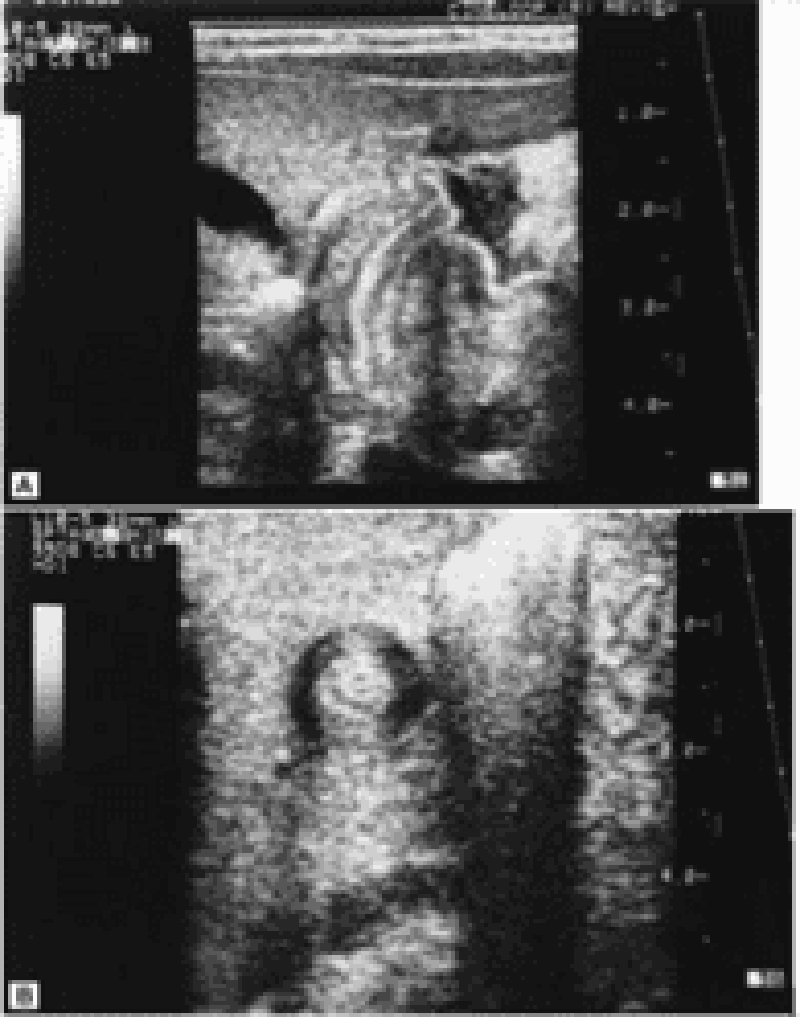
310) A 4-week-old boy presents with a 10-day history of vomiting that has increased in frequency and forcefulness. The vomitus is not bile stained. The child feeds avidly and looks well, but he has been losing weight. An ultrasound of the abdomen is shown. Which of the following is the most likely diagnosis?
A) Surgical consultation for pyloromyotomy
B) Upper GI with small-bowel follow through
C) Intravenous (IV) fluids alone to maintain hydration
D) Air contrast enema
E) Computed tomography (CT) of the brain
{"name":"Pediatric. kb 2", "url":"https://www.quiz-maker.com/QPREVIEW","txt":"151) An awake, alert infant with a 2-day history of diarrhea presents with a depressed fontanelle, tachycardia, sunken eyes, and the loss of skin elasticity. Which of the following is the correct percentage of dehydration?, 152) A 9-month-old is brought to the emergency center by ambulance. The child had been having emesis and diarrhea with decreased urine output for severaldays, and the parents noted that she was hard to wake up this morning. Her weight is 9 kg, down from 11 kg the week prior at her 9-month checkup. You note her heart rate and blood pressure to be normal. She is lethargic, and her skin is noted to be “doughy.” After confirming that her respiratory status is stable, you send electrolytes, which you expect to be abnormal. You start an IV. Which of the following is the best solution for an initial IV bolus?, 153) You are admitting to the hospital a 3-month-old infant who has been having poor feeding, emesis, and diarrhea for 3 days. In the emergency center, her electrolytes were found to be: sodium 157 mEq\/L, potassium 2.6 mEq\/L, chloride120 mEq\/L, bicarbonate 14 mEq\/L,creatinine1.8 mEq\/L, blood urea nitrogen(BUN) 68 mEq\/L, and glucose195 mEq\/L. She was given a fluid bolus in the emergency center and has subsequently produced urine. Which of the following is the most appropriate next step in her management?","img":"https://cdn.poll-maker.com/10-480510/screen-shot-2016-10-28-at-2-28-24-pm.png?sz=1200"}
More Quizzes
TDS QUIZ
1580
Appian Study Guide
31160
Not A Damsel
10513
100 GRILE SI
96480
Gynaecology & Obstetrics Clerkship - Free Practice
15816828
What Villain Am I? Free Personality
201016595
RMA Exam Questions - Free Practice Test for Certification
201020379
Latin Roots: Free Practice Online
201016371
The Most Dangerous Game - Free Short Story Trivia
201017322
Do I Have Scoliosis? Take the Free Self-Check
201017195
What Type of Narcissist Is He? Free
201018448
Knicks Trivia - How Well Do You Know the Knicks?
201016828